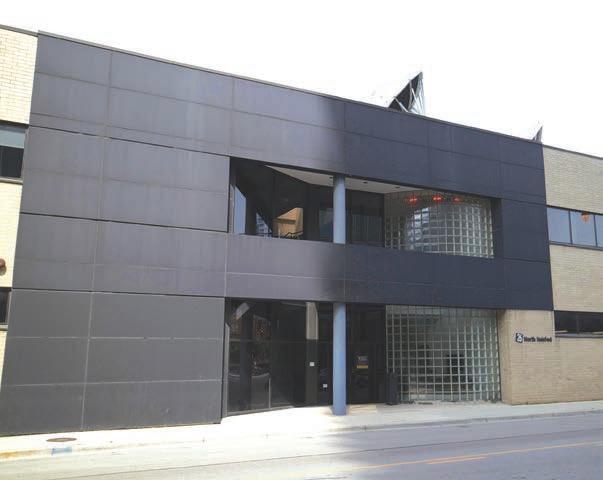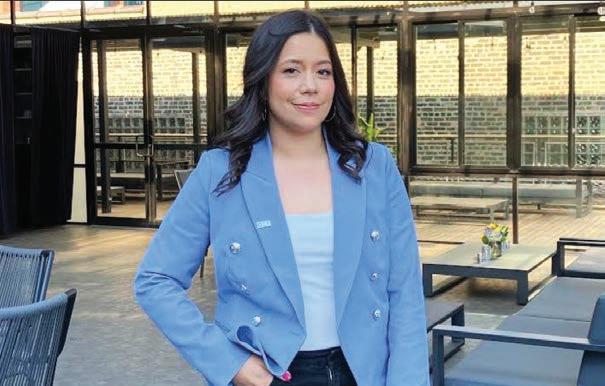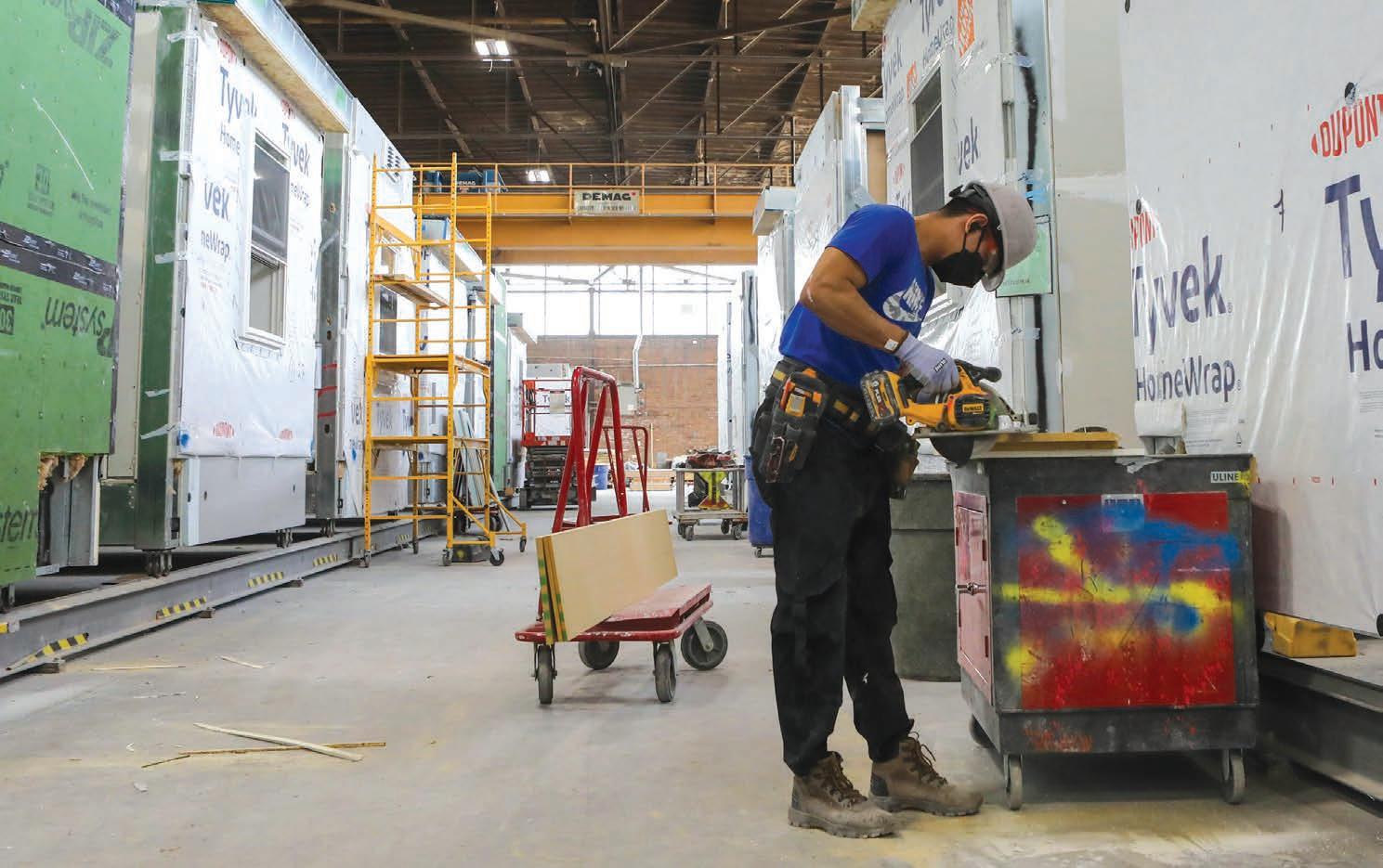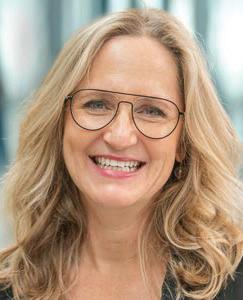

REDEFINING AFFORDABLE HOUSING
Chicago’s real estate community is trying several new approaches in the effort to make homeownership possible for working families | PAGE 11

Sellers struggling with downtown condo slump
Meanwhile, luxury-priced homes are in demand in other neighborhoods and in the suburbs
By Dennis Rodkine owners of a Pearson Street condo put it on the market in January with an irritating reality baked into the price: ey weren’t going to pro t on it.
e asking price they started with in January, $1.75 million, is the same number they paid ve years earlier for the threebedroom, 27th- oor condo a block from Lake Michigan. e unit sold May 9 for $1.55 million, a loss of a little more than 11%.
e Pearson Street sellers are among the latest of many who have “accepted the state of the market downtown,” said Brian Loomis, the Jameson Sotheby’s International Realty agent who represented the condo. “It’s a very frustrating market for sellers.”
It’s a long-running frustration at this point, four years into the reversal that COVID sparked and crime fueled, putting a deep chill into a sector that used to be one of the hottest parts of the

Chicago-area real estate market.
Perhaps most grating is the fact that “anywhere else you go, Wicker, West Town, the suburbs, the luxury market is back and it’s crazy,” said Matt Laricy, an
See CONDOS on Page 23
U of I tech founder came home from Silicon Valley to build a company in Fulton Market.
Sprout Social stock falls hard
The software company has stumbled in its move to chase bigger customers
By John PletzSoftware maker Sprout Social’s move upmarket to bigger customers is proving to be a much tougher climb than anticipated. Its stock price has fallen below $30 per share for the rst time since just after the company went public four years ago. Shares are trading around $28 apiece, down from $48.15 on May 2, before Sprout Social unexpectedly reduced its revenue growth forecast for the year to 22% from 28%.
“ is is about growth,” says Rob Oliver, an analyst at Robert

W. Baird, who downgraded the stock to neutral. “Small and midcap investors are growth investors. Growth expectations are considerably lower than they were before. When you gear your valuation toward growth and it changes, you see disproportionate changes in the stock.
“ ey’re pivoting to a company serving large companies, which isn’t easy,” he adds. “(Wall) Street had gotten comfortable with that and was taken by surprise things were not going as well as expected.”
See SPROUT on Page 23
Bears stadium proposal: Chicago won’t give up money it’s owed.
4

Littelfuse moving HQ to Rosemont office complex
An ongoing foreclosure lawsuit didn’t stop the company from inking a deal to relocate to the Riverway office property
By Danny EckerTen months after the owner of the Riverway office complex in Rosemont was hit with one of the largest foreclosure lawsuits ever for a suburban Chicago office property, the entity now controlling the buildings has landed the headquarters of a publicly traded company to its tenant roster.
Electronic component maker Littelfuse has signed a lease for 53,000 square feet at 6133 N. River Road in the Riverway complex near O’Hare International Airport, according to a statement from the company. Littelfuse will move its headquarters to the building at the end of this year from its current main office less than a mile east at 8755 W. Higgins Road, where its lease for 54,800 square feet expires around the same time.
It’s a rare example of a major company committing its headquarters to a distressed office property. Office tenants are typically wary of signing leases at buildings going through the foreclosure process, since lenders usually look to seize and sell off properties rather than pouring new money into renovations or leasing efforts. Signing a lease at a distressed property comes with the risk that the owner or lender won’t properly maintain the building or follow through with commitments like cash for office

As Littelfuse explored its options for a refreshed corporate headquarters near O’Hare, it got comfortable with Riverway as a viable option because Trigild and LNR are showing a long-term financial commitment to the property and its tenants, said Cresa Managing Principal Ed Lowenbaum, who negotiated the lease on behalf of Littelfuse.
The lease helps fill space vacated at Riverway by U.S. Foods, which consolidated its office at the complex in a 2019 deal.
buildouts, for example.
But with property values so decimated over the past couple of years by higher interest rates and remote work beating down demand, some lenders are choosing to play the long game on assets and competing for deals to try to recover some of the lost value.
That’s the case at Riverway, where a venture of Vancouver, British Columbia-based owner Adventus Realty Trust was hit with a $115 million foreclosure lawsuit last summer for allegedly failing to make a payment on the $128 million mortgage it borrowed against the building in 2016. Investment management company Wilmington Trust filed the complaint on behalf of bondholders in the loan, which was packaged with other loans and sold off to commercial mortgage-backed securities investors.
A Cook County judge in September appointed Dallas-based real estate firm Trigild as the property’s receiver, and Miami Beach, Fla.-based special servicer LNR Partners is overseeing the CMBS loan on behalf of bondholders.
The lender is continuing a multimillion-dollar capital improvement plan that Adventus had been working on prior to the foreclosure suit, with ongoing updates to the complex’s conferencing center and an auditorium and renovations to its outdoor space. Lowenbaum also verified other tenants that have signed recent new or renewed leases, such as benefits administrator Luminare Health and water systems treatment company Culligan, have received so-called tenant improvement allowances used for office buildouts.
“It’s definitely one of the best (office buildings) in Rosemont, with the hotels there and restaurants and amenities,” Lowenbaum said. The lender “has been putting money into this. Most (lenders) are just keeping the asset alive and the lights on, but (LNR) is doing active investment and they’ve shown a commitment.”
Lowenbaum declined to share terms of the lease, but called it a “strong agreement that protects Littelfuse backwards and forwards” regardless of what happens with the building’s ownership.
Spokesmen for LNR and Adventus did not respond to a request for comment. A Trigild spokesman declined to comment.
Littelfuse said in a statement
that the new Riverway office will be designed more efficiently than its current one, with space to help encourage employees to convene and collaborate.
“The move underscores our dedication to providing an exceptional work environment for our employees and fostering continued growth and success for our business,” Littelfuse CEO Dave Heinzmann said in the statement.
Founded in Chicago in 1927, Littelfuse designs, manufactures and sells a wide range of electronic components to major corporate
players in the electronics, automotive and industrial sectors. The company reported $2.4 billion in revenue in 2023, according to its most recent annual report.
The lease helps fill space vacated at Riverway by U.S. Foods, which consolidated its office at the complex in a 2019 deal, said Jones Lang LaSalle Executive Vice President Dan Svachula, who oversees leasing at the property.
Adventus’ portion of the Riverway complex includes three office buildings and a day care property just north of Interstate 90, and is
now about 72% leased, according to Svachula, up from roughly 61% early last fall. A Riverway building at 6111 N. River Road is owned separately and not involved in the foreclosure suit.
The Adventus property was just 58% in 2022, when it generated $4.9 million in net cash flow, according to Bloomberg loan data. That was just 60% of Adventus’ debt service for the year and less than half of the net cash flow the complex generated in 2016, when it was nearly full and Adventus bought it for $173 million.
Littelfuse’s impending departure from 8755 W. Higgins creates a new leasing challenge for Marvin Herb, the Barrington-based investor that has owned the 256,000square-foot building since 2006. Filling vacant office space has been especially difficult over the past few years, with changing work patterns recently driving the suburban office vacancy rate above 30% for the first time ever.
Littelfuse has signage atop the building, known as O’Hare Plaza II, where it has been located since 2009. The company is the largest tenant in the 11-story property, which is 90% leased, according to real estate information company CoStar Group.
A spokeswoman for the Herb venture declined to comment. Herb was the owner, chairman and CEO of Coca-Cola Bottling Company of Chicago, which he sold in 2001 to Coca-Cola Enterprises for $1.4 billion.
Lowenbaum and Cresa broker Liz Spence negotiated the lease on behalf of Littelfuse. Jones Lang LaSalle leasing agents Dan Svachula and Allyson Birchmeier represented building ownership.




Rick Bayless opening new spot in Skokie instead of downtown
The celebrity chef is opening a new Tortazo restaurant in Old Orchard mall, not in Chicago as he once had hoped |
By Jack GrieveCelebrity chef Rick Bayless is opening a second Chicago-area Tortazo restaurant, but instead of targeting a new downtown location, he’s taking the business to Skokie.
The fast-casual Mexican restaurant was set to open inside Macy’s at Old Orchard mall on May 25. “When the space became available, it was kind of a no-brainer for us,” Bayless said of the decision to target Old Orchard.
Bayless had hoped to open one or two new Tortazo restaurants in the Loop but opted for the suburban space instead as the downtown corridor continues to be plagued by its slow pandemic rebound.
“The Loop is not what it used to be pre-COVID, so we decided not to do that,” the Frontera Grill chef-partner said. “We’re waiting for the Loop to rebound before we put another place there.”

U of I tech founder chooses Chicago over Silicon Valley
The city is home, but it’s also an unconventional choice for Spencer Gore’s battery-tech maker, Bedrock Materials
By John PletzGrowing up in Naperville, Spencer Gore came to appreciate the scientists at Argonne National Laboratory during school field trips. After a decade in the Bay Area, he also came to appreciate how much more affordable his hometown was than his adopted home.
So when it came time for the University of Illinois graduate to build his second company, a battery-materials startup, he came back home.
Bedrock Materials set up shop in Fulton Market about a month ago. The startup will take its place alongside Nanograf, a Northwestern University battery spinout that’s making lithiumion cells on the Near West Side. They’re also part of a growing collection of companies related to electric vehicles, including automakers Rivian and Stellantis, bus manufacturer Lion Electric and battery producer Gotion.
Bedrock Materials has raised $9 million and has nine employees. The company plans to stand up an R&D and manufacturing facility of at least 15,000 square feet and create at least 25 jobs in exchange for tax credits under the state’s EV-incentive program that could be worth up to $2.8 million over 20 years.
Gore’s is exactly the kind of story that investors, business leaders, mayors and governors have been dreaming about for years: a homegrown tech entrepreneur who would choose to
build a cutting-edge company in Chicago to draw from its combination of talent, infrastructure and affordability. The surge in housing prices nationwide during the pandemic further heightened awareness of Chicago’s cost advantage.
Gore was at Stanford Universi-
The company plans to stand up an R&D and manufacturing facility of at least 15,000 square feet and create at least 25 jobs in exchange for tax credits.
ty, where he and his co-founder, Rafael Vila, were working on lithium-ion technology, which is used in EVs. But carmakers need to make EVs cheaper if they want to replace traditional vehicles. “We started asking ourselves, ‘Are we focusing on the wrong thing?’ ” he says. They settled on sodium as an alternative to lithium, an approach pioneered by Argonne. Their company is developing the powder used to coat cathodes inside batteries, which it plans to sell to battery makers. They produced their first prototype battery a year ago. Some Chinese
Lowering prices won’t fix McDonald’s marketing problem
The greater fast-food industry is grappling with an exodus of price-sensitive consumers. Here’s how they can be reeled back in.
By Erika Wheless, Ad AgeWhile stubborn food inflation has eaten into consumer purchasing power for years, reality has finally set in for fast food and restaurant chains—their value marketing is not working. This became clear in recent weeks as brands including Starbucks, McDonald’s, Pizza Hut and KFC reported disappointing quarterly earnings results with executives increasingly citing price-sensitive consumers as the culprit. While chains signaled more value marketing is coming—Mc-
Donald’s is reportedly working on a new $5 meal, for instance— just lowering prices won’t be enough, experts told Ad Age. Brands must streamline apps to more clearly communicate discounts and rewards, even putting themselves side by side with competitors to show who has the better deal. But in doing so, marketers must not stray too far from what their brand has always stood for. The challenge for some, including Starbucks, is that they have not made value a part of their core brand identity and risk sounding patronizing.
“There is a difference between
putting a deal out there and how it relates to the totality of the brand,” said Todd Sussman, chief strategy officer at FCB New York. “Creative done right can make value part of a brand’s story and not just a reaction to the economic times. You should be reacting, but in a way that does not discount the brand … You need to have a higher empathy for the moment and not just give a deal, but a value exchange. Consumers don’t want to feel like you’re giving them a handout.” Restaurant menu prices have

One silver lining under Bears stadium proposal: Chicago won’t give up nearly $50 million it’s owed
By Justin LaurenceA big selling point of the Chicago Bears’ proposal to tap into government bonds to help pay for a new lakefront stadium is it would save the city short-term pain tied to paying off the debt on Soldier Field. Left unaddressed was the fact the city would eventually get those payments, along with tens of millions in payments it’s already made, back.
As the Bears and Mayor Brandon Johnson have pushed for a deal to build a domed stadium with $900 million in public bonds while refinancing the existing debt on Soldier Field, an appealing aspect for city officials was the new repayment structure would smooth out looming annual balloon payments the city is illequipped to take on.
But an overlooked provision in the state legislation authorizing the 2% hotel tax that funds the Illinois Sports Facilities Authority ensures that, while those looming payments would mean short-term pain for the city’s annual budget, all of the money will eventually be repaid, beginning as early as 2033. If a deal for the Bears materializes in Springfield, the tax structure would remain in place, city officials confirmed to Crain’s. That would ensure the city receives what it’s owed, but could push out the repayment beyond 2033.
If no stadium deal for the Bears, Chicago White Sox or Chicago Red Stars were to materialize, the ISFA’s existing debt — largely tied to the 2003 renovations of Soldier Field — is set to be retired in 2032. But the structure of the debt, created by former Mayor Richard M. Daley, was backloaded, meaning the authority has primarily only paid annual interest payments while the principal was left untouched.
After all debt is retired, the 2% hotel tax would remain in place and the revenue would be used to

repay Chicago for the total amount the city spent making shortfall payments to the ISFA to cover the difference between its annual debt service and revenue from the hotel tax, as it has the past two years, with another $10 million projected in 2024.
After the city is paid back, the hotel tax would then be provided to the government entity that owns and operates McCormick Place and governs Navy Pier.
When asked if the city would seek to keep in place the repayment structure in any new deal with the Bears, city officials initially said the proposal was under review.
But May 15, the city’s chief financial officer, Jill Jaworski, said in a statement “the current proposal assumes the security and flow of funds for the ISFA bonds would not change.”
Under the proposal, the “city is not giving up the chance to be repaid,” she said.
“The current proposal projects that the hotel tax will provide rev-
enues in excess of 150% of debt service, which provides an opportunity for excess cashflow to be available to repay the city,” the statement said.
The Bears deal would refinance the ISFA’s current debt, create a $160 million liquidity reserve fund and issue up to $900 million in new bonds to pay for the new stadium, all to be repaid over 40 years at a total cost of $4.97 billion when interest is added.
The Bears declined to comment.
The ISFA’s annual debt service is projected to be $60 million in 2025, but ramps up to $79 million in 2030 and climbs to $90.5 million in its final year of 2032. With the pace of those annual payments rising faster than the annual projected growth of the 2% hotel tax, Chicagoans are on the hook for tens of millions in future costs.
Making up the difference
When hotel tax revenue, combined with $5 million annual sub-
sidies from the state and city, falls short, a portion of Chicago’s Local Government Redistribution Fund — tax revenue the state provides to local municipalities each year — is captured to make up the difference.
Currently, the total amount the city has lost to the ISFA payments is projected to be roughly $46 million by the end of the year, including $8.7 million in 2023, $27.3 million in 2022 and a projected deficiency amount of around $10 million in 2024, according to the ISFA’s 2023 audit and projections shared at its first quarterly meeting this year.
The Bears proposal would still require Chicago taxpayers to be the ultimate backstop to the ISFA’s debt service, but a new $160 million liquidity reserve fund would be created to serve as the first line of defense when the hotel tax revenue is insufficient to satisfy the agency’s annual debt payments.
While the city could benefit from restructuring the ISFA’s debt,
other aspects of the deal remain in the dark, including the parameters of a potential lease agreement between the Chicago Park District, which would own the new stadium, and the Bears.
The lease would set the team’s annual payment to utilize the stadium and lay out the revenue-sharing agreement between the district and the Bears, while spelling out who was on the hook for maintenance and operations costs.
Crain’s reported in April that the team, which would contribute $2.3 billion in private money to the stadium, is seeking the bulk of revenue from the new stadium, including from concerts and other sporting events. Mayor Brandon Johnson told Crain’s on May 11 that those details are left to be negotiated, despite his vocal support for the project.
The plan also calls for $1.5 billion in infrastructure improvements that are expected to be covered through state or federal grants.
Zara’s new Skokie store integrates in-store, online shopping
By Corli JayFashion retail company Zara opened a flagship store in Skokie on May 16. The new location is located in a 28,000-square-foot new development at Westfield Old Orchard mall, a 60% hike in space from its old spot at the same mall.
The company says the store creates an experience for shoppers that integrates both in-store and online shopping designed by Zara’s architecture team.
“Zara Skokie has advanced eco-efficiency systems that reduce environmental impact. These in-
clude efficient heating and cooling systems, energy-saving LED lighting and the use of more environmentally-friendly materials,” the company said in a press release. With the design, Zara says it is reaching its sustainability and efficiency goals by incorporating more natural light in the space and connecting the “Inergy” platform from its parent company, Inditex. The platform works by monitoring air conditioning and electricity consumption within the space and identifying opportunities for more “efficient systems, improving maintenance and


helping define strategies to reduce energy demand.”
The company has a goal to achieve climate neutrality by 2040.
In addition to Zara, global fash-

















































































Weigel Broadcasting sticks to the plan, 60 years on
The Chicago-based broadcaster has been a pioneer in the live TV space with expansions and partnerships, while also filling a niche
By Corli JayWeigel Broadcasting has found success tapping into the power of free over-the-air television since 1964, and that same mission has been its saving grace in 2024.
The Chicago-based broadcaster has been a pioneer in the live TV space with expansions and partnerships, while filling a niche that persists even in an era when on-demand media is king.
Earlier this month, the company announced its own Channel 26 “The U” as an independent station after Nexstar revealed it would move CW programming to the networks it owns such as WGN-TV. Weigel will also expand its portfolio this summer with the launch of the national network MeTV Toons. The channel
population with live local news, significant franchises in many program genres and events,”
Neal Sabin, vice chairman of Weigel Broadcasting, said in a statement to Crain’s. “Broadcast television remains a critical reach medium for advertisers and viewers.”
Weigel prides itself on being “the leader in the multicast television network space.” With its emphasis on free broadcasts, the company is proving the impact of over-the-air television in a media landscape that has become focused on streaming and seen a migration of cord-cutters who choose platforms such as Hulu and Netflix instead of cable subscriptions.
A recent study by the Television Bureau of Advertising shows linear, or traditional broadcast,
With local programming such as the news magazine show “On The Block,” Weigel satisfies the need for audiences that turn to over-the-air broadcasts for hyperlocal news.
is a spinoff of its popular retro Memorable Entertainment TV (MeTV) network that will feature classic cartoons 24/7.
“The media world may be focused on streaming, but there is still significant viewing being done on traditional TV platforms. Many are free, don’t require usernames and passwords, and satisfy wide swaths of the
TV is more effective for advertisement than ad-supported streaming platforms. According to the study, which uses U.S. Census Bureau data, “optimal reach can’t be achieved without the inclusion of linear TV.”
Hadassa Gerber, executive vice president and chief research officer at the nonprofit trade association, said many viewers see lin -
ear TV as trustworthy, with local news broadcasting as a big reason why.
“There’s so many more options that are out there and that people have to choose . . . but the reach of linear television is still like 80% in one day,” said Gerber.
Antenna usage
These channels are often viewed with the use of an antenna. Anne Schelle, managing director of the business organization PearlTV, which works to innovate broadcast TV, said “self bundlers,” viewers who use an antenna while also paying for streaming platforms, are growing as broadcast companies expand their reach.
Schelle says audiences are increasingly learning there is quality TV available that they don’t have to pay for, using the popularity of the show “Yellowstone” starring Kevin Costner after it began airing on broadcast as an example.
“I think their total viewership for that was 2 to 3 million people (when) it was only available on their streaming platform. They decided to distribute it on their linear broadcast. Guess what happened? Viewership went sky high,” said Schelle. “That’s a different consumer. It’s not the same. The reach and frequency of broadcast is huge.”
According to another study by the Television Bureau of Advertising, the number of households that only rely on over-the-air

broadcasts has increased by 55% in the last 12 years.
Linear TV has also had continued success with sports viewership. One of the most extreme examples, the Super Bowl, continues to be the most-watched program in the nation; this year’s game set a record with a 7% increase in viewership at 123.4 million viewers, according to CBS Sports.
Weigel has carved its own niche by airing high school competitions. It’s also benefited from the WNBA’s burgeoning popularity by airing Chicago Sky games. In a multiyear deal with Cincinnati-based broadcaster E.W. Scripps, the WNBA increased its audience by 24% with its “WNBA Friday Night Spotlight” show on the TV broadcast channel ION.
Back in March, Weigel announced a simulcast with Marquee Sports Network of the spring training game between the Chicago Cubs and Milwaukee Brewers. Such partnerships with companies like Warner Bros., CBS and the Illinois High
School Association have elevated Weigel.
With local programming such as the news magazine show “On The Block,” Weigel satisfies the need for audiences that turn to over-the-air broadcasts for hyperlocal news.
Just as the required update from analog to digital helped provide more opportunities for over-the-air channels, Schelle of PearlTV said such advances will only lead to increased success for broadcast companies like Weigel.
Developments like NextGenTV, which was recently picked up by five Chicago stations, provide higher quality and an immersive experience for antenna TV, helping to create more of an interest in such programming and resulting in growth for the space.
“(People) realize it’s not that hard to take an antenna and connect it to your television and get a lot of free stuff,” said Schelle. “We’re giving (viewers) more. . . .They’re recognizing there’s huge value in that.”
World Business Chicago launches gender equity office
By Leigh GiangrecoWorld Business Chicago will launch a new gender equity office this summer, with the Chicago director of GET Cities at the helm.
Elle Ramel will transition from GET Cities to her new role as director of the office later this summer. Before joining GET Cities in 2020, Ramel directed redevelopment of the Michael Reese Hospital site for Farpoint Development and worked on economic development under Mayor Rahm Emanuel.
Gender Equality in Tech, or GET, Cities, a philanthropic initiative backed by Melinda French Gates and dedicated to increasing gender representation in the tech industry, announced it would shut down its chapters in Chicago and other cities this month, Miami Inno reported. Ramel maintains GET Cities
Chicago’s plan was always a fiveyear run, with the intention of subsuming itself into a local organization. In that sense, GET Cities isn’t closing so much as porting over its existing programs.
“World Business Chicago has been a partner since the very beginning,” Ramel said, adding the two organizations have already collaborated on entrepreneurship programs.
World Business Chicago has flown over 20 founders to conferences in cities like Miami and Toronto to help them fundraise capital, with plans to send more to New York later this year, she added.
“So when I was thinking about a place where we could think about growing inclusivity in the innovation economy, World Business Chicago has always been one of our starting partners and continual partners,” she said.
While Ramel will bring her

tech expertise to the table, the gender equity office will take a broader look at gender equity across other industries like finance, life sciences and quantum computing, she said. She plans to leverage her tech equity network of 15 organizations including Out in Tech, an LGBTQ
tech nonprofit, and Latinas in Tech.
“What I would love to support the most in this is retention of technical workforce or gender equitable workforce,” she said.
“How do they look for career opportunities, doing more mapping of how do they get to man -
agement, how do they lead?”
As Ramel transitions to World Business Chicago, she’ll bring over initiatives like the GETSeed Founder Cohort, which raises funds for startups spearheaded by women, trans and nonbinary founders.
GET Cities has partnered with Chicago:Blend, a nonprofit advancing diversity in the venturecapital and startup space, to help fund the mentorship program Chicago Venture Fellows. They also helped kick off funding for TechRise at P33, a tech development program fostering Chicago’s Black and Latino entrepreneurs.
“I've had founders that are driving from Indiana, not only women, but trans and nonbinary founders from the Midwest, saying, ‘This is a place where I can grow my business, there's programming that reflects me,’” Ramel said. “We're not just going to start these businesses, we're going to keep them growing.”
Johnson pitches Quebec leaders on Chicago’s ‘blue and green economy’
The mayor met in Montreal with companies focused on sustainability, water management
By Leigh GiangrecoIn a bid to position Chicago as the center of a burgeoning “blue and green economy,” Mayor Brandon Johnson met in Montreal with Quebec companies focused on sustainability and water management.
“Chicago’s proximity to one of the largest bodies of freshwater in the world is a competitive advantage that has been historically underutilized,” Johnson said in a statement to Crain’s. “We are working hard to identify and interact with economic sectors where we have an edge, so that we can attract sustainable businesses and good jobs to our city for long-term success.”
World Business Chicago's vice chair, Charles Smith, and Alaina Harkness, executive director of Current, joined Johnson in a roundtable hosted by financing corporation Investissement Québec, where the mayor hopes to attract and expand those companies’ footprints in Chicago while minimizing their carbon footprint. The roundtable highlighted the mayor’s trip to Montreal for the Great Lakes & St. Lawrence Cities Initiative annual meeting, where businesses and government leaders focus on using the region’s freshwater resources responsibly.
In an exclusive interview with Crain’s, Smith and Harkness touted Chicago’s strategic position on the Great Lakes and its access to clean water as a major draw for businesses.
“I do want to emphasize something, though, that there is a correlation between good policy and business growth in the green and blue economy,” Smith said. “Because what we want to do is encourage business growth and see businesses thrive without having to compromise the health and safety of the environment.”
Broader strategy
While Smith declined to elaborate on the specific companies at the closed-door meeting, he said the group would include “leading Québec companies” in the sustainable development, transportation, water management and green economy sectors that have either expressed an interest in investing in Chicago or have existing operations that they’d like to expand.
The meeting in Montreal reflects a broader strategy from World Business Chicago to spur investment in green businesses. In October, Johnson and Gov. J.B. Pritzker introduced the Chicagoland Climate Investment Alliance,
a new organization dedicated to pushing eco-friendly startups and climate investments in the Midwest. The group, with public and private partners like World Business Chicago and Invenergy, focuses on securing federal grants for climate-resilient technologies developed in the Midwest.
“What I do know is that for most small businesses and startup businesses in this space, government grants are their first sources of income and revenue and opportunity,” Smith said. “So that publicprivate partnership is really important.”
Economic silver lining
Harkness, who leads Chicagobased water innovation nonprofit Current, has warned of the existential threats to the global water supply, from contaminants to coastal flooding. But she sees an economic silver lining with the potential to develop technologies that could clean and manage water. In January, the National Science Foundation awarded a $160 million grant to Great Lakes ReNEW, a coalition of research partners led by Current from six Great Lakes states aiming to clean and extract valuable minerals from wastewater.
“Current’s role has been to bring the industry together with research and development leads, startup small businesses and community partners to build a vision for the blue part of this blue-green economy that we're talking about here in Montreal today,” Harkness told Crain’s. “That's all the businesses that are heavy water users, as well as the businesses that are creating solutions to water needs.”
As of last week, Exelon and Ingredion joined Current’s industry consortium, and more plan to join the ReNew initiative, she said. Though traditional industries like agriculture and manufacturing have used large amounts of water in their production, the tech sector can also strain water supplies. That doesn’t mean Chicago should shy away from those companies, according to Harkness.
“What we need to do is think ahead to use our water differently,” she said.
So far, Chicago’s abundant water resources have not forced it to deal with water reuse in the same way as Western cities, Harkness added.
“So we tend to not do that very well,” she said. “We have a real opportunity to start to think differently and to be able to recruit companies that are the future of the region.”

EDITORIAL
A golden age of female-led philanthropy
The news that Ashley Duchossois Joyce has been elevated to chairwoman of her family’s namesake investment firm, Duchossois Capital Management, is the latest confirmation of a trend that’s been evident for a few years now: Family firms are increasingly looking to daughters — not just sons — to lead key enterprises, and that leadership is also contributing to a golden age of female-led philanthropy.
Sure, there’s plenty to lament about the state of women’s progress in corporate C-suites: Only about 10% of CEO positions in the Fortune 500 are held by women. But in the realm of family offices, where generations of parents, siblings and cousins often participate in decision-making about a clan’s business endeavors as well as their giving, there’s evidence a positive shift is taking place.
In the case of Chicago’s Duchossois dynasty, Ashley Joyce, 48, is stepping up to the role held by her father, Craig, for years, representing the third generation to lead a sprawling family enterprise with roots in rail-car manufacturing but over time came to encompass consumer products, technology and service-sector holdings. In 2021, the Duchossois Group sold Chamberlain Group to Blackstone in a deal valued at $5 billion, wealth that’s helped fuel the Duchossois Family Foundation, of which Joyce has been chairwoman since 2022, and which has been a major contributor to the University of Chicago, the Field Museum and more.
PERSONAL
VIEW

It’s far too early to say whether Joyce’s elevation to the top role at her family’s business empire will result in any appreciable changes to the family foundation’s giving, but she joins the ranks of other significant decision-makers with enormous say in how their family funds will be deployed.
Locally, some of the most prominent female philanthropists in this realm include:
Environmentalist Wendy Abrams, a member of the Mills family of Medline fame, who has funded the Abrams Environmental Law Clinic at the University of Chicago as well as other climate-centric causes.
Penny Pritzker, the entrepreneur and civic leader who, along with husband Bryan Traubert, has led the Pritzker Traubert Foundation, a major investor in community economic development, workforce training and efforts to strengthen democracy.
Heather Steans, a former state senator who serves as chairwoman of the Steans Family Foundation, which was created by her father, Harrison, a banking executive, and which focuses on catalyzing economic opportunity in North Lawndale and North Chicago.
LGBTQ+ advocate Laura Ricketts, whose
philanthropic work has included helping to run her family’s Chicago Cubs Charities organization.
Liz Thompson, CEO of the Cleveland Avenue Foundation for Education, who along with husband Don, former CEO of McDonald’s, is focused on promoting educational opportunity and entrepreneurship in the Black community.
Helen Zell, who as executive director of the Zell Family Foundation, built with her late husband, Sam, has been a major supporter of the arts, including the Chicago Symphony Orchestra and the Museum of Contemporary Art.
These local efforts stand beside the global work of MacKenzie Scott and Melinda French Gates, who have without question become two of the most consequential philanthropists of our age, having leveraged the wealth they helped build while married to ex-husbands Jeff Bezos of Amazon and Microsoft’s Bill Gates, respectively, into large-scale giving aimed at medicine and housing, hunger and education, promoting women in technology and elected office, and beyond.
It wasn’t so long ago that a young woman in a family as influential as the Duchossois clan might have been passed over in favor of a male relative when the time came to hand down the torch of family leadership. So it’s inspiring to see Ashley Duchossois Joyce take the reins — and it’s also refreshing to note she’s in good company, particularly when it comes to philanthropic leadership.
Race is the Midwest’s economic Achilles’ heel
Well known to Midwest economic development officials and state and local leaders, in today’s knowledge-driven economy, communities wage what Midland, Mich., Mayor Maureen Donker described to me recently as a “war for talent.”
And for the many formerly manufacturing-dependent communities dotting the shores of the Great Lakes and sprinkled among the region’s fields and forests, the opportunity to both keep one’s homegrown talent and attract newcomers by offering a community that is less expensive, less congested and less hurried, with a rich quality of life, is a handhold toward new population and employment growth.
There is good evidence that quality of life and place — like good schools, transportation options and outdoor recreation opportunities — matters more today than traditional “business-friendly” measures like low taxes and lax regulation in keeping talent at home and attracting new
John Austin directs the Michigan Economic Center and is a nonresident senior fellow with the Brookings Institution.
Marwan Mikdadi of the University of Michigan contributed to this piece.
jobs and new people.
And there are growing signs of some movement of well-educated workers, including the important tech talent that is central to business growth in so many emerging sectors, now seeking alternatives to living in the coastal hothouses with their spiraling housing costs, gridlock, and dirty and degraded community fabric.
Many Midwest community leaders are looking to seize these opportunities to foster new growth. Particularly advantaged are those whose communities sport a great natural location, like along a Great Lake or riverfront, or are home to one of the many premier universities in the region that can serve as strong fulcrums for building an innovation-driven economy, as well as enrich the arts, cultural and entertainment environment.
This dynamic appears to be gaining steam as attractive outdoor and lifestyle communities in the West, New England and a tier of counties across the beautiful northern part of Great Lakes states have seen an influx of better-educated, high-income newcomers over recent years.
But for many Midwest metropolitan communities, the lingering legacy of racial segregation and divided communities may be off-putting to diversity-seeking talent who can now find the atmosphere of
inclusiveness and tolerance they value in some of the fast-growing cities of the South like Austin, Texas; Atlanta; Houston; and Nashville, Tenn.
As we’ve written before, the industrial cities of the North have long been hamstrung economically by the most intense racial divides in the country. These northern industrial communities were once a destination of hope and opportunity. The early 20th century saw the Great Migration of Black and white laborers from the South and Appalachia flocking to the Midwest’s mills, factories and machine shops and the decent jobs they provided. This migration threw races together in Northern cities. But rather than a happy melting pot, white Northern community leaders aggressively worked to keep the races apart. Those cities soon enabled and encouraged the flight of white residents (and their businesses, jobs and wealth) to the suburbs, while strict discriminatory housing and educational policies kept Black residents confined in increasingly segregated communities.
The result is, the region boasts the nation’s most racially and economically balkanized metropolitan communities. The industrial cities of the North and Midwest make up the lion’s share of the most segregated metropolitan regions in the country,
as measured by the dissimilarity index. Led by Milwaukee and Detroit, six of the nation’s 10 most segregated cities are in the industrial Midwest and Great Lakes region.
This separation has many damaging effects on Midwestern cities’ economic, political and social health, crippling decision-making and our ability to organize metropolitanwide solutions — for example, functional regional transportation systems that facilitate access to good jobs for all residents, which are still largely absent in communities like Milwaukee and Detroit. The redlining practices, school district line-drawing and deeded covenant practices in Northern cities have been gone for several years, but the resulting segregation is “baked in” today.
As Brookings Institution demographer William Frey told The Hill, with many Northern cities having lost or seeing stagnant populations since the 1960s, residents are older and communities are lacking in the “refreshment” of new, younger residents with different attitudes and expectations. Frey says: “In the Northern metros, those old neighborhood patterns are much more stuck in place. It has to do with where people grow up, it has to do with old patterns of discrimination.” He also notes that the cities attracting new residents in recent
years are adding people of all ethnic groups without the stigma of those past racist practices.
Now the Northern industrial states with their strictly segregated metropolitan communities are largely losing out on the movement of talented and often more well-off people to more diverse and richer-quality-of-life communities.
Looking at data on migration of high earners, none of the 12 Midwest industrial states rank above 24 in the nation for net migration of high earners. In fact, nine Midwest states are showing a net high-earner loss. This includes:
Illinois, with a net migration of -9,131
Iowa, -187 Michigan, -99
Minnesota, -1,453 Missouri, -38
New York, -19,795 Ohio, -1,258 Pennsylvania, -1,022 West Virginia, -82
While many of the highly segregated metros of the Midwestern and Northern industrial states are losing out, either experiencing population decline or slower population growth, most of the fastest-growing metros, including in terms of attracting the most new higher-income migrants, are also among the more diverse and least segregated. For example, the Black-white dissimilarity index for many metros in the South and West is around 60 or below; that compares with Northern metros in which Black populations are either slowing in growth or declining, such as Milwaukee, New York, Chicago, Cleveland, Detroit and St. Louis, where segregation levels are closer to the 70s.
Interestingly, some of the cities that gained the most in terms of youth population are concentrated heavily in the South, including Austin; Orlando, Fla.; Raleigh, N.C.; and Nashville. These communities have also experienced a significant influx of younger families as well as immigrants bringing their families, thus contributing to these areas’ younger populations, as immigrants and the children they have in the U.S. are younger compared to the rest of the nation. So, given the decline in the population of young white people since 2000 as more white Americans age out, areas with more diversity also happen to be the ones gaining the most in terms of population in a highly causal way due to immigration. These cities are also reflected in a Brookings Institution demographic analysis depicting the growth and decline of the population of people under 18 within U.S. metros. The places with growth rates of 5% or more include some earlier mentioned metros like Austin, Nashville, Orlando, Houston and Raleigh, while cities experiencing declines of 5% or more are scattered across the industrial Midwest, including Milwaukee, Detroit, Chicago and St. Louis, all cities that were listed as having some of the highest segregation indexes out of U.S. metros, per the 2020 census.
This is not a new trend. Going back to the period 2000-2010, the Population Reference Bureau in a 2011 release of census data observed, “U.S. cities with high levels of growth and new construction tend to be less segregated,” and — quoting Penn State University demographer John Iceland — “segregation persists in older cities in the Northeast and Midwest where a large share of the nation’s African American residents live, ‘buttressed by a history of poor race relations and continuing discrimination,’” while “metro areas in the South and West tend to have more mobile populations, fewer Blacks and sometimes no long-established Black
community. . . .The difference is ‘easy to see in a short drive through Milwaukee or Detroit, where there are starkly Black and starkly white neighborhoods that you don’t see to nearly the same extent driving in places like Tucson or Las Vegas.’”
An analysis from the Economic Innovation Group also shows the places experiencing the largest growth of higher-income earners tend to be centered throughout the Sun Belt. Meanwhile, apart from northern Great Lakes and New England lifestyle communities, the heartland regions of the North and Midwest continue to lose this demographic.
A painful irony for the Midwest,
and a worry for our country, is that just as the economic dynamics may favor new economic opportunity and a new economic storyline for many Midwest communities, based on unique assets like universities, an outdoor lifestyle or even smalltown charm and a simpler, saner quality of life, the lingering realities of segregation and discrimination may be off-putting to those who can help deliver on that opportunity.
And the longer some Midwest industrial communities continue in decline — losing residents, losing tax base to provide basic services, seeing diminishing job opportunities and degraded community physical conditions — the more angry
and resentful working-class white residents become. This in turn finds them increasingly intolerant and easily whipped to resentment of immigrants or people of color as somehow getting something like government benefits or job opportunities at their own expense. Residents of once-mighty but today in decline heartland communities remain responsive to the polarizing political movements that threaten our democracies from within.
Unless Midwestern communities can come together to acknowledge and treat our race-driven Achilles’ heel, our own economic future and the political future of our nation remain imperiled.







Recognize a Black leader making a difference in their industry and community.



PEOPLE ON THE MOVE
ACCOUNTING / CONSULTING
John Kasperek Co., Inc.
Calumet City / Mokena

Meagan Turner joined the John Kasperek Co., Inc. team in 2023 as an intern out of Governors State University (GSU). Through her internship, Turner gained experience in the firm’s consulting practice including processing payroll and monthly bank reconciliations. She recently earned her Bachelor of Science in Accounting from GSU and has accepted a full-time Associate role with the firm. Turner is also actively preparing for the Certified Public Accountant (CPA) licensure exam.

ARCHITECTURE / DESIGN
Lamar Johnson Collaborative Chicago
Lamar Johnson Collaborative (LJC) has promoted Joe Procunier

LEED to Associate Principal. His extensive expertise in advanced manufacturing, life science, higher education and more makes him a valuable resource to clients looking for architectural solutions to drive business forward. Joe holds a Master of Architecture and a Bachelor of Environmental Design, Architecture from Montana State Univ.-Bozeman.

LJC has promoted Mike Siciliano AIA to Associate Principal. His multifaceted experience in architectural design, construction knowledge, and collaborative rapport lead to innovative solutions customized to each project’s specific needs. Mike holds a Bachelor of Science in Architectural Studies from the Univ. of Wisconsin-Milwaukee.
ARCHITECTURE / DESIGN
Design Workshop, Chicago
Design Workshop, an international landscape architecture firm, has promoted Sara Egan to a principal. Egan is a registered landscape architect and a national certified planner. Her work in the Chicago region began by facilitating a vision to re-sculpt the heart of Wheaton’s public realm. Over the last decade, Egan and her team supported the City in the implementation of this vision creating streets and public spaces for gathering, commerce, and recreation.
LAW FIRM
Laner Muchin, Chicago

Laner Muchin is pleased to welcome Lauren Cook as an associate.

Lauren concentrates her practice in business immigration, representing employers of all sizes and industries who seek to sponsor foreign nationals and families under a broad range of immigrant and nonimmigrant visa categories. She has experience handling immigration matters before U.S. Citizenship & Immigration Services (USCIS), the U.S. Department of Labor and the U.S. Department of State.
LAW FIRM
Laner Muchin, Chicago

ENGINEERING / CONSTRUCTION
Ardmore Roderick, Chicago
Ardmore Roderick welcomes Emeka Okafor as Vice President of Energy and Utilities! With nearly two decades of experience in the energy and utility sector, Emeka has held key leadership roles in distribution engineering, operations, vegetation, and asset management. His dedication to fostering equitable opportunities aligns with our mission and will be vital in driving success for our clients and communities. Emeka will play a crucial role in our growth strategy in the Energy & Utilities markets.

Laner Muchin welcomes Eileen Lysaught as of counsel. With over 30 years of experience in business and corporate counseling, she assists clients with matters related to commercial agreements, corporate formation, general counsel services and business and employment law counseling. Her practice includes counseling clients on matters involving commercial concerns and compliance with federal, state and local laws regarding leaves of absence, accommodations, discrimination and harassment.
LAW FIRM
Laner Muchin, Chicago



Croke Fairchild Duarte & Beres LLC
Chicago
Croke Fairchild Duarte & Beres welcomes Penelope Campbell Ari Krigel as partners in the firm’s high-profile Real Estate practice group. Penelope brings significant experience across all aspects of commercial real estate and has played a pivotal role in transactions related to retail, shopping center, industrial, warehouse, office, hospitality, multifamily and manufactured housing matters. Ari represents clients in the commercial real estate space including large institutional investors, national and regional lenders, and mid-market real estate investment and development companies across a variety of matters and development projects.
Trident DMG, Chicago / DC


Krigel
Logan Booth joins Trident DMG, a Washington, D.C.based strategic and risk advisory firm, as SVP. With experience as an attorney and a McKinsey consultant, Logan is based in Chicago and will focus on strategic, litigation & investigations communications, stakeholder engagement, and crisis/risk advisory for critical issues at the intersection of media, reputation, policy, law, and business. With global experience, Trident is nationally recognized as a top advisory firm, including in Chambers.



MEDICAL
IV Solution & Ketamine Centers
Chicago

American Community Bank & Trust amcombank.com

Laner Muchin welcomes Andrew Slobodien as of counsel. Andrew concentrates his practice in labor and employment law, with a focus in employer-union relations. He possesses extensive experience handling all manner of labor relations and has regularly practiced in federal and state courts and before the NLRB, EEOC and similar state and local agencies.

Dr. Bal Nandra was recently awarded an Ellis Island Medal of Honor. One of our nation’s most prestigious awards, its recipients are read into the Congressional Record. A pioneer in the ketamine industry for mental health, Dr. Nandra leads the team at IV Solution & Ketamine Centers of Chicago. His clinic’s outcomes for depression, anxiety, PTSD, addiction and other mental illnesses are industry leading. He has made it his life’s work to make ketamine accessible to everyone who could benefit.
American Community Bank & Trust announces the opening of a new commercial banking office, located at 17W220 W. 22nd St., Oakbrook Terrace, under the leadership of Steve Davis, EVP. The office expansion supports a talented team of commercial bankers recently hired to build full-service commercial banking relationships with small to mid-size companies in the Chicago area. American Community Bank & Trust is a privately held commercial bank headquartered in Woodstock, IL with assets of $1 billion.





















REDEFINING AFFORDABLE HOUSING
Chicago’s real estate community is trying several new approaches in the effort to make homeownership possible for working families | By Judith Crown
Carpenters at an assembly plant in North Lawndale are putting the finishing touches on Tyvekwrapped rooms of a modular home to be delivered to a customer in Homan Square. It’s designed to be “affordable,” but the homes built by Inherent L3C sell for $390,000. Not exactly a bargain price. True, there’s down payment assistance and other subsidies to help first-time buyers defray their costs. Inherent CEO Tim Swanson aims to get the price down by scaling up production and raising equity through tax credits.
Swanson is part of a real estate community trying to make homes more affordable for working families, a purchase that could help them build wealth to pass along to their children. Experts estimate that the city needs at least 120,000 affordable units and nearly 300,000 statewide. While affordable rentals are in high demand, new homes also could revitalize long-depressed neighborhoods and help attract supermarkets and other amenities.
Modular homes like Swanson’s help fill the gap because they can be constructed indoors all year and are

not subject to the weather. And developers on the South and West sides are trying to expand the supply by acquiring and building on the thousands of vacant lots owned by the city. But the slow pace of acquisition is a
SPONSORS
stumbling block, experts say.
The Cook County Board last month launched a pilot program to provide $3 million in down payment assistance to advance affordable homeownership. A second pilot, in partnership with the Cook County Land Bank Authority, is allocating $12 million for the construction of homes in Humboldt Park, Maywood and Chicago Heights. That includes working with Swanson’s Inherent Homes for modular units. The County Land Bank Authority and South Suburban Land Bank & Development Authority also offer abandoned homes at below-market prices to developers and buyers interested in rehabbing the properties or building on vacant lots.
Still, other homes in the city and suburbs are being sold through trusts — financial instruments that keep a lid on home prices.
Over the past two decades, the cost to build a modest three-bedroom house has nearly doubled to between
See HOUSING on Page 14
Renters seeking a mortgage must know the keys to homebuying
Rising rents and gentrification are prompting longtime renters to consider homeownership
Housing counselors at the Far South Community Development Corp., or Far South CDC, are advising an increasing number of renters interested in buying a home.
With higher property taxes and expenses, landlords are raising rents throughout the Chicago area. In gentrifying neighborhoods such as Pilsen, East Humboldt Park and Hermosa, renters are being displaced altogether. And that’s prompting longtime renters to consider a leap into homeownership.
Many Black renters are unfamiliar with the process of buying a home because their families weren’t homeowners, says Janece Simmons, vice president of community and housing services at Far South CDC. But often they get a nudge from a friend who’s bought a home and take a closer look. And there’s a wider recognition that homeownership helps build family wealth, she says.
In some ways, it’s a difficult time to buy. Mortgage rates are high and homeowners with low rates are sitting tight, which depresses the supply of available properties. But there’s a good supply of down payment assistance and help for closing costs available through government sources and lenders. “I tell clients, ‘You can layer it like a cake,’” says Pamela Stalling, vice president of the Housing and Fi-
nancial Empowerment Center at the Chicago Urban League. Longtime systemic barriers make it difficult for some Black and Latino buyers to cross the threshold. Lenders became more restrictive after the subprime mortgage crisis of 2007-2010 and look for higher credit scores, says Marisa Calderon, CEO of the nonprofit Prosperity Now. The minimum credit score for a Federal Housing Administration, or FHA, loan is 580, but lenders are requiring higher scores to ensure they can sell the loan, she says.
New construction appraisals
When developers build in a struggling neighborhood such as West Humboldt Park or Back of the Yards, appraisers may penalize the new construction by comparing to older homes in lesser condition. That could imperil a loan and require the buyer to make a larger down payment, or for the seller to either lower the price or find a grant to cover the gap. On the other hand, buyers of affordable homes in a gentrifying neighborhood can get beneficial loan terms with higher appraisals.
First-time homebuyers seeking down payment assistance are required to take a course through U.S. Department of Housing & Urban Development-approved local agencies that explain the basics of the mortgage process, insurance, inspection and appraisals. Still, a lot more tutoring and
hand-holding comes into play. While banks will approve loans based on a client's gross income, counselors like Stalling warn borrowers, “you don’t live off your gross.” She advises borrowers to budget conservatively based on their net income and consider all monthly expenses. You can be a well-educated professional and not understand how the system works, she says. “If there’s no financial literacy, you can lose everything.”
By Judith Crown Black homeownershipJohn Groene, neighborhood director at Neighborhood Housing Services of Chicago, tells clients to get pre-approved for a mortgage. He often gets calls from clients asking about grants but has to tell them it’s useless to talk about down payment assistance until they know what they can borrow.
“I had a client who had her eye on a house on Central Park Avenue. Did she get pre-approved? No,” Groene says. “She didn’t have enough for the down payment and she lost out on her dream house.”
At Far South CDC, counselors are seeing more prospective buyers older than 40, including seniors. One client in her 70s purchased a home for the first time under the Chicago Housing Authority's Choose to Own Homeownership Program, which covers a portion of the mortgage for voucher holders. “She has children and grandchildren and wants to leave them something,” Simmons says.
Chicagoans see this piece of the American Dream slipping away
We often think of the American Dream as having a spouse, two kids and a dog, and owning a home. Beyond its sentimental value, homeownership can be a wealth-creation catalyst. This path to financial security is increasingly out of reach for Chicago’s low- to middle-income families, however.
Half of city of Chicago residents (51%) are concerned about their local housing situation, according to a recent Harris Poll survey. To put this in perspective, Chicagoans’ worries about housing trump their concerns about the refugee and undocumented im-
 William Johnson is CEO of The Harris Poll, a global public opinion polling, market research and strategy firm.
William Johnson is CEO of The Harris Poll, a global public opinion polling, market research and strategy firm.
Chicagoans believe that there is not enough reasonably affordable (43%) or low-income housing (29%) where they live.
migrant situation (46%), the local economy (33%), infrastructure (28%), social inequities (25%), health and community resources (25%) and the public education system (23%). The only issues about which city residents are more concerned are public safety
(64%) and taxes and fees (59%). Specifically, Chicagoans believe that there is not enough reasonably affordable (43%) or low-income housing (29%) where they live, and 2 in 5 say that the situation has worsened over the last year. Fifty percent fear that they will be priced out of their neighborhood within five years. And city residents are looking to local political leadership to help deal with this chronic problem: A plurality (47%) said that city government should be primarily responsible for managing the housing situation in the area where they live.
To his credit, Mayor Brandon Johnson has focused on addressing the problem — though with mixed results to date. In March, voters narrowly rejected his initial effort, dubbed "Bring Chicago
Home,” which would have raised the real estate transfer tax on million-dollar-plus real estate deals. Johnson has subsequently shifted his strategy away from using tax increases to deal with the problem. In early April, he announced plans to convert unused space in four financial district office buildings into apartments, with some portion being affordable housing. Two days later, he rolled out “Cut the Tape,” a large-scale initiative designed to streamline housing and commercial project development. The proposals aim to reduce unnecessary building requirements, cut extraneous reviews and alleviate administrative burdens. If successful, it could both increase the housing supply and improve affordability.
“This strategy will quickly increase residential and commercial projects, stimulating business sectors and addressing the urgent need for housing,” Johnson said. “Together, we're breaking down barriers to progress and building towards a more prosperous city for all.”
Taken together, these plans could be a step in the right direction for the city, and a majority of Chicago residents support the construction of reasonably affordable
housing (76%), additional housing (60%) and low-income housing (60%) where they live, according to our polling. That said, residents may believe it when they see it:
Nearly two-thirds of Chicago residents (62%) think it’s likely the city’s housing situation (e.g., availability, affordability) will actually decline over the next five years.
One key for Johnson will be engaging with other city leaders on this agenda. This would be smart politics in a couple of ways: Not only could it increase the chances of getting his agenda enacted, but even simply making the effort is likely to boost him in voters’ eyes.
Fully 9 in 10 city residents think it’s important for the mayor to work with others such as aldermen and union leaders on issues facing the city, with nearly two-thirds (63%) saying it’s very important. Chicagoans are pragmatic and understand that solving the city’s problems will require careful solutions and, most importantly, everyone pulling together. They want to see Johnson, other pols and key stakeholders such as business executives alike demonstrate that they get it as well.
That’s the challenge of leading a big city — and the opportunity, if

Who should handle housing?
In your opinion, which group should be primarily responsible for managing housing in the area where you live? Source: The Harris















$350,000 and $400,000. And that’s with eliminating the basement and garage. Meanwhile, price tags for homes in gentrifying Chicago neighborhoods such as Logan Square, Pilsen and Albany Park range from $500,000 to $1 million. With landlords raising rents due to higher property taxes, more tenants are looking to homeownership, housing counselors say. But stubbornly high interest rates coupled with elevated construction costs make the transition difficult. Moreover, many prospective Black and Hispanic buyers are skittish because they aren’t familiar with the homebuying process.
“It’s not part of their daily learning,” says Janece Simmons, vice president of community and housing services at the Far South Community Development Corp. “They see the $300,000 number and figure it’s unaffordable. But there are methods to purchasing that home.”
Homeownership by Black and Hispanic families grew in the years leading up to the 2008 subprime mortgage meltdown. But as much as two-thirds of household wealth among these groups was lost in the foreclosure crisis that followed, says Marisa Calderon, president and CEO of the nonprofit Prosperity Now.
Homeownership in Chicago and Cook County declined between 2010 and 2022, according to the Black Wealth Data Center and the American Community Survey. In Cook County, ownership among white families dropped by 3.7% to 66.1%, outpacing the drop in Black homeownership of 1.9% to 40.9%. Ownership among Hispanic families gained by 1.4% to 53.4%. The gap remains substantial: In Chicago, Black homeownership fell to 34.6% in 2022 compared to overall ownership of 45.6%.
Seeking economies of scale
Since launching Inherent L3C in 2020, “to enable and empower long-term affordable homeownership and generational wealth creation,” Swanson has delivered seven homes and was recently completing three more, selling to both developers and directly to consumers.
Trained as an architect, he’s worked at design firms Skender, CannonDesign and Skidmore Owings & Merrill.
Swanson expects to build 25 modular homes this year and double output to 50 as he moves into a larger production space and converts to an assembly line format. Under the current setup, workers construct one house at a time in three bays.
Still, Swanson says he’s breaking even on low volume and expects expansion will enable him to lower costs and gain supply chain efficiencies, much like the Walmart model.
His team members work with prospective buyers, helping them find down payment assistance and grants for closing costs — whether from the city or private

Homeownership rates (2010 vs. 2022)
Change in homeownership (2010 vs. 2022)
four earning about $90,000. The lack of private investment means dependence on government for subsidies and approvals, says Josh Braun, former CEO of Kinexx Modular Construction, a builder selling to affordable housing developers. And those wheels move slowly. Modular makes sense if production can be streamlined and scaled, Braun says. “You need orders of 100, 200, 300 and 1,000. That allows you to get economies of scale, like automakers who are building millions of cars,” he adds.
Last month, Braun sold his majority stake in the company he started in 2019 to a Kinexx investor, LaPhair Capital Partners, a New York minority-led, earlystage investment firm. LaPhair invested more than $2 million to acquire Braun’s ownership, pay down debt and shore up credit lines, says the new CEO, Scott Upshaw.
Under its new ownership, Kinexx aims to boost volume to operate more efficiently and seek new revenue streams. That includes tapping into new markets, possibly Detroit or Houston, according to Upshaw, a business development consultant and lecturer in management at Chicago State University.
Kinexx has delivered 69 homes, including 28 to developer Mike Drew of Structured Development for his Harrison Row Townhomes in East Garfield Park. Drew is selling them at an affordable $250,000, well below his per-home cost of $350,000. There was no financial backing from the city. Drew selfsubsidized the development by building 400 market-rate rentals in Lincoln Park. “It was a developer’s gamble that the value in Lincoln Park will more than offset the cost of building on the West Side,” he says.
Chicago’s Affordable Requirement Ordinance, or ARO, requires developers who seek a zoning change to make 20% of their units affordable. Drew fulfilled that requirement by building 34 affordable condos in Lincoln Park and 40 affordable townhomes offsite in East Garfield Park.
Median home value (2010 vs. 2022)
lenders. But it’s a burden on firsttime buyers to arrange their own “capital stack” of financing.
Swanson’s solution is the New Market Tax Credit Program — a tool traditionally used for com-
mercial development but has been used for workforce homes in 30 states, including Atlanta, Indianapolis, Houston, St. Louis and Austin, Texas.
With that equity, Swanson fig-
ures he can sell a house for $290,000 and hopes to offer a 3.5% mortgage. That would free prospective buyers from the burden of scrambling for subsidies. And it would be affordable to a family of
The majority of compliance with the city’s inclusionary housing policy is through affordable rents. Affordable homes built to fulfill ARO requirements are governed by the city’s Chicago Housing Trust, which sets income limits for buyers but requires that they qualify for a mortgage. It has more than 120 units in its portfolio. Residents agree that when they sell, it will be at a restricted price to keep the home affordable. “The priority is to provide stable housing for workforce families that enables them to avoid unscrupulous landlords,” Drew says.
One new resident at the Harrison Row Townhomes is Christian Boyer, director of development at the Chicago Loop Alliance. Boyer heard about the Housing Trust program through friends and says it took some time to understand the guidelines and then apply. He paid $249,000 for the home and landed $10,000 in down payment assistance from the Illinois Hous-
ing Development Authority. Because the home was appraised higher than his cost, he only had to put 3% down. He moved into the four-bedroom, two and a half bathroom home last summer.
“I never thought I would have enough money to own a home in Milwaukee (his hometown), let alone Chicago,” he says. The home is close to his job and is near the Green and Blue Chicago Transit Authority el lines, but he adds, “There’s still work to be done in the community.”
In North Lawndale, a tour of a new Kinexx modular home shows off a wrought iron fence, a kitchen with a large island, Samsung appliances and two baths. A concrete slab for parking can be used to build a garage later. The home doesn't have a basement. (Swanson of Inherent Homes says he is working on prototypes that would include basements — finished or unfinished).
The lack of a basement is a disadvantage because families need a place to stash their stuff, says John Groene, neighborhood director at the Neighborhood Housing Services of Chicago. He has a client paying $300 a month for a storage unit. “If you can afford to borrow $315,000, you probably will choose an older home with a basement,” he says. “You have a choice.”
Neighborhood Housing Services works with families to buy and renovate the homes. A typical deal might involve the purchase of a vacant home for $200,000 and a $150,000 rehab. In some tax-increment financing districts, where a portion of property taxes are dedicated for redevelopment and investment, a subsidy can cover 25% of the entire project.
This type of deal keeps the neighborhood affordable, Groene says. If a market-rate developer gets the same property first, he’ll add in a fancy kitchen and bath. “The developer will sell it for $400,000 and it's no longer affordable for many families,” he says.
Forgoing the profit
Like the Chicago Housing Trust, other land trusts run by nonprofits keep homes affordable by restricting resale prices. The buyer essentially owns the home, but the land remains in a trust with a renewable 99-year lease. The homeowner agrees to keep the home affordable and can’t sell at a big profit, even in a hot neighborhood like Logan Square.
The suburb of Highland Park established the first land trust in the state in 2002, when home prices were taking off and the community wanted elementary school teachers and paramedics to be able to live where they worked.
The Highland Park Community Land Trust expanded to nearby suburbs and merged with other affordable housing organizations to form the nonprofit Community Partners for Affordable Housing,

trifying neighborhoods where local organizations aim to keep a diverse population. It’s not a presence in striving neighborhoods, such as North Lawndale, where residents would welcome an appreciation in home values.
Vacant land waiting
What is top of mind for Richard Townsell, executive director of Lawndale Christian Development Corp., is acquiring a chunk of the estimated 10,000 city-owned vacant lots in Chicago. He and other leaders on the South and West sides have ambitious plans to build thousands of homes on vacant city land. But gaining approval is painfully slow, negotiating with six or seven different city departments for a standard 1,700square-foot home that is being replicated.
The city allocated 100 lots to Lawndale Christian Development, but the organization has received only 14, says Townsell, adding that he thinks the city is skeptical of his organization’s ability to deliver and is doling out the land.
The nonprofit is building on those lots as well as on privately owned land it’s acquired. But Townsell is worried about missing another construction season. “Builders will move on to other, more certain projects,” he says. “They’ve been waiting for us for a long time.”
Lawndale Christian Development is part of the coalition United Power for Action & Justice, which is building affordable homes in the Back of the Yards, Roseland and Chicago Lawn neighborhoods, as well as Lawndale. The consortium has sold 24 homes and has 70 under construction. (Townsell has purchased modular units from Kinexx but also uses on-site builders.)
At a minimum, the consortium is looking for the release of 500 lots during Mayor Brandon Johnson’s four-year term, translating to 150 a year for the four communities. “If we move fast, we should get more lots,” Townsell says. Releasing the lots will at least get the properties on the tax rolls. “If I build a house and don’t sell it, it’s on me to pay the taxes,” he says.
or CPAH, based in Libertyville. CPAH’s Community Land Trust program builds and rehabs homes for low- and moderate-income households. It has nearly 89 homes in its portfolio in Highland Park, Lake Forest, Evanston, Wil mette, Highwood, Mundelein and Lake Bluff, says Amy Kaufman, CPAH's vice president of community relations.
In Chicago, the nonprofit Chicago Community Loan Fund leads a governing federation, the Chicagoland Owners Land Trust. Last year, the fund extended a $1 million letter of credit to a recent
initiative, the Here to Stay Community Land Trust, which operates in Logan Square, Hermosa, Humboldt Park and Avondale, where gentrification is a concern. Here to Stay acquires and renovates the homes in its portfolio, says program director Kristin Horne. The trust has sold three homes ranging from $270,000 to $290,000 and uses a variety of funds to subsidize the transaction. It has two houses under contract and two more in renovation.
One of Here to Stay’s buyers is Ludivina Resendiz, who was set
to close on a four-bedroom, twobathroom home in Hermosa for $275,000. She and her family lost an earlier home in the foreclosure crisis and was recently renting in Logan Square.
“I’m grateful for the opportunity,” says Resendiz, a surgery scheduler at Rush University Medical Center. She says she accepts that she won’t have the opportunity of a financial windfall when it’s time to sell. “My intention is not to make money,” she says, “it’s about a home for my family and making memories.” Trusts are best suited for gen -
Townsell and other developers hope Johnson’s plan released in April to “Cut the Tape” and speed the approval process for real estate projects will change the paradigm. The mayor unveiled a report with more than 100 recommendations to speed up the approval process for new developments and help ease the shortage of affordable rentals and homes. However, much of the report is based on goals to be completed over months or years. A task force will be created to track progress. John Roberson, the city's chief operating officer and point person on the "Cut the Tape" initiative, did not respond to requests for comment on developers' needs for the vacant parcels.
“If we get the lots, we would build,” Townsell says. “All the city has to do is get out of the way.”
Closing critical housing gap demands state-level action
Illinois' affordable housing crisis is harming more families than ever. The time is now for state leaders to act to relieve the burden on the working families we serve.
In Illinois, our housing shortage has been worsening for a generation. Over the last decade, our housing deficit has grown by 64%, leaving us with 300,000 more families unable to access affordable housing. This housing gap means that low-income Illinoisans are severely burdened by housing costs, with close to 75% of the households most in need of affordable housing spending over half of their income on rent.

housing market overall — renters and homeowners end up paying more, no matter their income.
Across the board, rapidly increasing housing costs are straining communities, harming local economies by limiting the ability of families to spend and save, and leading to rising homelessness.
For these reasons, I introduced the Build Illinois Homes Act. The act would create the Build Illinois Homes state tax credit, which would invest $20 million annually to incentivize affordable housing development over six years.
Households forced to devote most of their income to housing face harrowing trade-offs and may forgo medical care, child care, food, or other essentials. Without swift intervention, this crisis will continue to grow more severe.
The affordable housing shortage impacts everyone, not just lowincome renters. When families are forced to rent outside of their means, this puts pressure on the
The Build Illinois Homes Act is a consensus policy, drawing support from a diverse group of stakeholders, including real estate, business, labor, and housing advocacy groups. The bill enjoys such broad support because it is a commonsense investment that addresses an urgent need while generating economic activity, creating jobs, increasing state and local tax revenue, and bolstering
federal and private sector investment in our communities.
Currently, almost all affordable developments in Illinois are financed by federal tax credits. When these tax credits are insufficient, shovel-ready developments are unable to move forward, leaving federal and private sector dollars on the table. The Build Illinois Homes state tax credit is designed to bridge these funding gaps, helping private developers take advantage of available federal funding.
Just one annual funding round from the Build Illinois Homes state tax credit will lead to the construction of over 1,100 new affordable homes. A modeling estimate from the National Association of Home Builders predicts this will generate $500 million in economic benefits over 10 years, including over $125 million in state and local tax revenue and over 7,000 new jobs.
State tax credits for affordable developments are offered by 25 states, including our neighbors in Wisconsin, Indiana and Missouri. Since just 2018, Wisconsin’s tax credit has helped finance nearly 5,000 new affordable homes. A study of Georgia’s tax credit found

that its cost has been more than offset by its return, generating roughly $6 in economic activity for every dollar spent and financing over 90,000 new affordable homes.
Perceptions of affordable housing need to meet the moment
The topic of affordable housing has made headlines in recent weeks with cities big and small grappling with how to confront the affordability crisis. A study from the Joint Center for Housing Studies at Harvard University finds that housing in the United States remains unaffordable for over half of the nation’s renters. Chicago mirrors this national challenge as substantial declines in the affordable housing supply have led to the largest affordability gap in at least a decade, according to the Institute for Housing Studies at DePaul University. To understand why, we need to understand the challenges and offer creative solutions.

Lisa Davis is a partner in real estate and head of asset management for The Vistria Group. Vistria is a sponsor of Crain’s Forum.
First, affordable housing has a perception problem. It is often seen as negatively impacting a community, when in fact many times it has the opposite effect. For example, communities often think that affordable housing lowers property values for surrounding housing. Data from New York University’s
Furman Center for Real Estate & Urban Policy found that affordable housing does not depress neighboring property values and may even raise them in some cases. Additionally, communities also have misconceptions about who needs affordable housing.
Typically, affordable housing is defined as a tenant paying no more than 30% of their income toward rent, with low and moderate income defined as earning below 80% of area median income. In Chicago, that is $89,700 for a family of four. In many cities, this could be an annual salary for our teachers, first responders, entry-level employees and government workers. In fact, the vast majority of non-disabled, workingage residents of affordable housing work outside the home — they just don’t make enough to afford a typical, non-subsidized apartment.
Second, in addition to improving housing and access to opportunity in low-income communi-
ties and affordable housing, we need to build and preserve affordable housing in neighborhoods that have strong public institutions that drive economic mobility. The opportunities here are both in ground-up development of more multifamily housing in these locations and also preserving affordability in existing multifamily housing.
The Vistria Group recently invested in one such community in Naperville Township, Haven at Long Grove. It's directly across the street from three schools in the Indian Prairie School District, one of the best, not just in the state, but in the country. When The Vistria Group purchased Haven at Long Grove, it committed to keeping at least 50% of the apartments at rents that are affordable to families making less than 80% of area median income. The Vistria Group is continuing to work with DuPage County to increase the affordability for lower-income families as well. Affordable housing must exist in every community and must create “access to opportunity” for residents at all levels of income and stages of life.
Lastly, to succeed, we need to
encourage enduring collaboration. Most local governments are not real estate developers, but the policies they promulgate are essential to affordable housing creation and preservation. Because affordable housing is not synonymous with "cheap," we need substantial funds to build and preserve this type of housing, whether through public financing programs or property tax abatements.
The Vistria Group recently invested in such a project in New York City, which will result in the preservation and physical improvement of 1,700 apartments through a partnership with the New York City Housing Authority. Along with the physical improvements, resident programming tailored to the needs of each building will connect community members to opportunity. As investors, The Vistria Group believes that private capital, local governments and responsible property owners can create more sustainable opportunities for affordable housing that meets the needs of current residents and future generations.
Over seven years, Colorado’s tax credit led to $1.4 billion in private sector investment, supporting over 30,000 jobs and financing almost 10,000 affordable units. Closing

However, let’s be clear: The Vistria Group’s affordable housing investments make up a small fraction of the larger housing landscape. Business leaders, investors, nonprofits and government need to work together to preserve and create millions more units across the nation. So,

Illinois’ housing gap is a longterm strategy that will require years of planning, collaboration and smart investment. Passing the Build Illinois Homes Act is a commonsense step we can take right now. With the affordable housing shortage getting worse each year,

Create more entry points to solve the housing crisis
Chicago, like many large cities in the U.S., is experiencing an affordable housing crisis. Demand has increased while new options have not been developed. Public-private partnerships may offer a more impactful solution by developing more projects than the city can handle alone. CIBC US is committed to reducing housing insecurity by creating more entry points for affordable housing. Our Community Development team believes that thinking differently and working collaboratively can lead to identifying opportunities for new development, redevelopment and rehabilitation. Through partnership and imaginative utilization of spaces, we can establish more affordable housing while sustaining and strengthening communities.
Solving for affordable housing involves more than simply providing a reasonably priced place to live. It is about building and sustaining communities that offer access to good schools, strong jobs, public transportation and local shopping. Lower housing costs create opportunities for individuals and families to pursue their ambitions and create generational wealth by saving money that would otherwise be spent on rent to achieve another goal like homeownership, entrepreneurship or higher education.
At CIBC, our beliefs and commitment are reflected in the diversity of projects we support, some of which are in communities with abundant amenities that require a unique approach in order to provide affordable housing.
A good example is 4715 N. Western Ave., which CIBC financed as part of a public-private partnership. The transit-oriented development transformed a single-use surface parking lot into a mixeduse space in an upper-income neighborhood. The structure now has 63 affordable housing units, retail spaces, and private and public parking spaces.
In areas with fewer amenities, creating access to affordable housing can be more achievable. The CIBC Housing Initiative improves access to capital in needier communities by providing flexible construction financing to rehabilitate vacant homes. Empty dwellings often have a detrimental effect on neighborhoods, and rehabilitation can help by expanding the supply of affordable housing while increasing home values and the community tax base.
To date, CIBC’s Housing Initiative has provided financing in several Chicago neighborhoods and Cook County suburbs focusing on low- and moderate-income communities. In these areas, we have addressed the difficult issue of un-

dervalued property appraisals by leveraging the full resources of the bank, ensuring that fair and accurate appraisals reflect the true values of rehabilitated homes. Entry points for affordable housing can be as unique as the communities where they are found. CIBC has long supported programs at The Chicago Lighthouse and provided an innovative financing solution for the organization’s Foglia Residences. The development repurposed a parking lot into safe, affordable, and accessible housing for people who are blind or visually impaired, making it the first of its kind in the U.S. Chicago has a culture of collaboration that supports affordable housing development. Public,
private, and philanthropic interests can work with city and state governments to find innovative solutions. Tax incentives and initiatives, like Mayor Brandon Johnson’s "Cut The Tape" report and the approved bond issue that will invest $1.25 billion in affordable housing and community development, support and accelerate this work. CIBC has been a leader in these efforts, partnering with organizations to maximize the impact of affordable housing initiatives.
As a bank, we bring financing and discipline to projects to ensure developments are high-quality and completed on time. Over the past decade, CIBC has financed 55 projects, preserving more than 5,320 affordable housing units. Through our U.S. Community Development Lending program, we have provided construction loans amounting to over $320 million and permanent debt exceeding $27 million to support these initiatives. Additionally, we have invested $443 million in tax credit equity, both in proprietary and shared investments, demonstrating our commitment to creating sustainable and inclusive communities. At CIBC, we believe in fostering private and public partnerships for community growth and success. Together, we can drive meaningful change and create vibrant communities where the dream of affordable housing is a reality for all.

Chasing a brighter future on the Far South Side
How do you stay in the place you call home without being moved around?
How do we get residents in my community into a sustainable situation?

Those are the questions we in the Riverdale neighborhood on the Far South Side are asking as we anticipate big changes as a result of the Red Line extension. The Chicago Transit Authority’s Red Line currently goes only as far as 95th Street, but the “el” will be extended to 130th Street by 2029, with construction slated to start next year. Obviously, this will have a huge impact on all the communities in the southeast corner of the city, including Riverdale, Manor Park, Concordia Park, Golden Gates, Eden Green and Altgeld Gardens, a public housing complex where I have lived since 1985. The median income in Riverdale is just $13,518, which means that if we don’t create options for our neighbors and ourselves, we won’t have
Beria Hampton is president and CEO of the Altgeld Murray Homes Alumni and a 2023 Goldin Institute Chicago Peace Fellow.
any options.
Built originally for veterans, Altgeld Gardens’ military-style row houses were all full and flourishing with gorgeous flower gardens when I was a child. The families who lived here were African American and mostly had members who served in the U.S. Armed Services, and we had a strong sense of community and connection to the rest of the city. Today, Altgeld is less than half occupied, and several whole blocks have been demolished, leaving a lot of vacant land. Although there are many families in need of housing in our city, a lot of Altgeld units are vacant. Currently, the development doesn’t even have a grocery store, and the space where one once existed is empty.
The organization I head, Altgeld Murray Homes Alumni Inc., works with a host of partners in the area, including Wayfinding, the Calumet Collaborative and People for Community Recovery.
For too long, we’ve been com-
peting with each other for the same grants and support. We all need the help, however, so we decided to collaborate.
Together, we are working with an array of partners as well as the city, county and state and federal governments to create a community land trust, a nonprofit organization that would acquire land in the area for public, cooperative uses. I see the land trust as a multipurpose organization, promoting economic development and helping other organizations turn their ideas into reality.
Using resources we gather through the land trust, we have big plans for our neighborhood, which has lacked investment for decades. We’re working with NeighborSpace, a nonprofit urban land trust that preserves gardens on behalf of community groups, to create a community farm that would produce food crops. One collaborator has a vision to turn empty space at a local school into an Environmental Justice Institute. We’re contracted with the state Department of Commerce and Economic Opportunity’s Navigators program to help our community take advan-

tage of the transition to clean energy sources with jobs and moneysaving opportunities. I would love to see something similar to the Garfield Park Conservatory in my own community.
One important question we ask with all of these projects is how they can create jobs for our residents. We want the land trust to help build new affordable housing for people who need it and help
existing residents own their own units so they can pass them down to their families or to someone in the same predicament they were in. We’re trying to get city land to make it all happen.
We’ve got to connect our residents to resources and help them leverage their own so they can have real choices and a safety net. We are trying to move fast to catch up with what’s already happening.
Suburbs are rethinking what affordable living can be
Affordable housing today is defined by opportunity. Previously considered the domain of the city, affordable housing is expanding throughout Chicago’s suburbs. Some suburban communities are welcoming, even inviting, new affordable housing projects into town.

Richard Koenig is executive director of the Housing Opportunity Development Corporation, based in Skokie.
Today’s affordable housing is privately owned, well managed, near amenities, beautifully designed, safe and desirable. Often confused with its cousin public housing, affordable housing is a complex issue that generates complicated emotions. In the Chicago area especially, images of the Chicago Housing Authority's infamous Cabrini Green often jump to mind. But the reality is, that model doesn’t exist anymore. Affordable housing now looks just like other new developments. At its core, affordable housing simply provides homes where prices are restricted and reserved for households that earn belowaverage incomes.
Suburban affordable housing is defined by amenities: close to grocery stores and shopping, good schools and stable employment options. Affordable housing allows working families to live near their jobs rather than commuting long hours. It allows seniors to stay in
the town where they raised their children but can no longer afford the property taxes. It helps people with disabilities live near their support networks (like Housing Opportunity Development Corporation’s Spruce Village in Palatine), not in institutions hours away, doubled-up or in their parents' basement.
Affordable housing is now defined by options. Some are created by market-rate developers who are required by inclusionary zoning laws to include a percentage of affordable units. Most are created one deal at a time by assembling a complicated array of financing, sometimes referred to as “lasagna financing” due to all the funding layers. The primary source is low-income housing tax credits, which are in limited supply and often oversubscribed 4-to-1. Affordable housing is not cheap to develop, but with little debt, rents can remain low. More funding is crucial to meet the growing demand. Families making $15 to $20 per hour can afford to pay $800 a month (less than half the market rate) for a two-bedroom apartment at HODC’s Cleland Place, a 16-unit development in Wilmette.
Despite the need for affordable homes, it takes time to create. Nonprofit and for-profit develop-

ers spend years putting together deals that rival market-rate projects in quality and design. A recent success is Zion Woods, a new 25unit development in Deerfield. Zion Lutheran Evangelical Church offered to donate its land to HODC in 2014. After a protracted zoning fight, $1 million in site work to tame a river, and a complex funding package from the Illinois Housing Development Authority, financing closed in March 2024, 10 years later.
Sadly, affordable housing is of-
ten defined by NIMBY battles where neighbors (who “love” affordable housing, just not “here”) fight to stop proposed projects based on fears of who might live there someday. It is also defined by political leadership. Every new project requires municipal approval, so village leaders must vote affirmatively to allow affordable housing in the face of sometimes virulent opposition. Deals can take years to get zoning approval against the protests of neighbors who complain about
anticipated negative impacts on property values, schools, parking, density, etc. Even when these negative impacts never materialize, each new project in another suburb means a new skirmish. Affordable housing today can be defined by inadequate supply, long delays, zoning struggles, insufficient funding and high costs. But it is also defined by elegant design, desirable locations, professional management and rich amenities — which we all desire for our home regardless of geography.
CRAIN’S DINING AND ENTERTAINMENT GUIDE
AIRE ROOFTOP BAR
100 W. Monroe St., 24th Floor, Chicago, IL 60603 773-598-8324 • airechicago.com
Embark on a refined experience as Aire Rooftop Bar reopens its doors on May 19th. Discover an array of new cocktails and menus tailored for discerning palates, ideal for sophisticated business luncheons. Delight in our enhanced happy hour offerings and weekly highlights, accompanied by live musical performances. From lunch to dinner, join us in elevating your evenings amidst breathtaking views starting May 19th.

DOLCI AMORI
West Loop: 494 N. Milwaukee, Chicago, IL 60654 Lakeview: 3025 N. Clark St., Chicago, IL 60657 Gold Coast: 2 W. Elm St., Chicago, IL 60610 312-414-0955 • dolciamori.com
Dolci Amori, Chicago’s authentic Italian pastry shop founded by Napoli native Ciro Longobardo, blends traditional “Italian Pasticciera” and “Rosticciera.” Our top priority is always freshness and quality. Explore unique contemporary Italian pastries, pizzas and paninis crafted by our renowned team from Italy, led by a 40-year experienced Pastry Chef.

MORETTI’S RESTAURANTS
Visit our website for our locations across Chicagoland morettisrestaurants.com
Moretti’s was founded in Chicago and is 100% family-owned and exclusive to the Chicago area. The original Moretti’s is on the northwest side of Chicago. Ten other locations serve the north and west metro area. Moretti’s original family recipes range from traditional to the latest delicious trends. All ingredients are fresh, and everything is handcrafted to order.

CLASSIFIEDS
Advertising Section
To place your listing, contact Suzanne Janik at (313) 446-0455 or email sjanik@crain.com .www.chicagobusiness.com/classi eds
CAREER OPPORTUNITIES
hasanopeninginChicago,ILfor
FnncbsnssprtnrtoleadtheheadofGlblFnctnsofHmnRsrcsandCrprtarsofPrcrmnt,Strtgy Trnsfrmtn,andHQ(C-Stecstpols).PstnreqrsaBchlr’sdgrorafrgneqvlntinAccntng,Fnance,orBsnss Mngmnt,and5yrsofwrkexprncinjoboffrdorrltd.Telecommutingispermissible.$197,246peryear.To apply,emailresumetoBikashitaSaikiaatBikashitaLeema.Saikia@nielseniq.com&refjob#REFID168915.
seeks -
Rsrch,dvlp,&implmntproprietarytrdgstrategsthrghthecrtn&implemofcmplxquantitativemdels tospprtthecmpny’strdginfrstrctre.
Master'sdeg(U.S.orfrgnequiv)inMathematics, Stats,ComputationalFinance,orarltdmathematicalorquantitativefield&three(3)yrsofexpin jobofferedorrltdquantitativedataanlssorenggrole.Emailresumetohr2@sunrisefutures.comref. VicePresident,QuantitativeResearch–JobID#00066.
CAREER OPPORTUNITIES



AUCTIONS
Hub International is on the hunt for targets
By Mark WeinraubHub International, a private equity-backed insurance brokerage, is forging ahead with its strategy of growth through acquisition despite stubbornly high interest rates and lingering inflation.
The interest rates have slowed M&A activity among smaller insurance agencies, but the field remains highly competitive among bigger players like Chicago-based Hub, with prime targets still attracting multiple bids, according to Clark Wormer, Hub’s managing director of mergers and acquisitions.
“Some of the firms in our industry had taken on too much debt in the past, and they have effectively had to shut down M&A,” Wormer said in an interview. “Hub never did that. We were one of the lowest-levered private-equity-backed firms in the world in terms of insurance brokerage, and thus the interest rates have not had the impact on us as they have with some more highly levered firms.”
Hub, owned by private equity’s Hellman & Friedman since 2013, completed 65 acquisitions in 2023, down from 70 a year earlier but good for the top spot in the insurance industry, according to Optis Partners, an investment banking and financial consulting firm that advises companies about M&A.
During the first quarter of 2024, Hub closed 10 deals, the third most in the industry and well behind leader BroadStreet Partners, which closed 29.



“Certainly, interest rates have impacted M&A across all spectrums of every industry. For us, what it has focused on is ensuring that we continue to only focus on the best-in-class businesses,” Wormer said. “We are more disciplined with our capital because, frankly, it costs more money.”
Despite the slow start to the year, Hub still has its sights set on total acquisitions in 2024 equaling or even surpassing the 2023 level, Wormer said. The company has picked up the pace recently, making four deals since the start of April.
“The interest rates really are not affecting the large firms,” said Timothy Cunningham, managing director at Optis. “They typically fund their bread-and-butter deals out of cash flows. They don’t need debt to fund their deals. It is still a very robust market.”
Hub, a provider of property, casualty, life and health insurance, along with employee benefits, investment and risk management products and services, reported an enterprise value of around $23 billion after receiving a substantial minority investment from Leonard Green & Partners about year ago. Canada’s Altas Partners also holds a stake in the company.
“In the last 10 years, private equity has fallen in love with our industry,” Wormer said. “We have world-class partners that have helped turbocharge our growth.”
The company’s acquisition plan is driven by the heads of its 35 geographic units in the United States and Canada, who report their needs and potential targets in their area to Wormer’s team.
“When you think about an acquisition strategy, you are not thinking about one acquisition strategy for 65 or 70 deals a year,” Wormer said. “We are really talking about 35 bespoke tailored acquisition strategies, with each of those regions looking for the specializations, for the type of people, for the certain niches, to fill out what they are looking for in their unique geography.”
Hub’s website also features a page where insurance firms considering a sale can reach out to the company directly. The site, which receives about five inquiries a week from potential acquisition targets, features videos from key employees explaining the benefits of becoming part of Hub and even Wormer’s phone number.
A new spot for tacos and margaritas opens overlooking the Chicago River
By Jack Grieve



















One of downtown Chicago's most recognizable street corners is now home to a new seasonal Latin American restaurant bringing build-your-own margaritas and "walking tacos" to a shaded patio overlooking the river.



CocoBar opened in earnest on May 1 on the southern edge of the Wabash Avenue Bridge after a soft opening last fall. The outdoor dining area looks out over the Vietnam Veterans Memorial and Marina City, with front-facing views of Trump Tower.
The restaurant is the product of sisters Leticia and Erika Espinosa, who moved to Chicago from Mexico City some 15 years ago, along with partner Gabriel Neely-Streit. They spent the last five years running Colores Mexicanos, a Mag Mile Mexican gift shop, only to decide they had the bandwidth to do more, hence the decision to

dabble in dining with the opening of CocoBar.
"We're trying to represent our Mexican community," Leticia Espinosa said. For her, the restaurant's unique location allows them to showcase Chicago's storied Hispanic culture to downtown foot traffic full of folks who might not otherwise see that side of the city.
"We're trying to explain who we
are — one of the biggest communities in Chicago," she added. "It can be something new for them."
At CocoBar, expect $15 margaritas, $12 quesadillas, beer buckets, tequilas, mezcals and more.
The shaded patio space at 316 N. Wabash Ave. was previously occupied by Chicago Brewhouse, which continues to operate on the lower level of the building.







TECH FOUNDER
From Page 3
EV makers are using sodium-ion batteries, but the technology hasn't been widely adopted. "No one has found the right formulation," he says.
Gore, 32, says he wasn’t homesick but hungry for talent in choosing Chicago. “(Argonne) was a natural choice for us because that lab cranks out dozens of experienced post-docs who know everything there is to know about creating sodium-ion batteries.”
Still, Gore acknowledges, “Chicago is an unconventional choice for doing battery research and development. The conventional markets for this are San Francisco and Boston.”
There’s just one problem with the conventional wisdom.
“If you think about it, not for
MCDONALD’S
From Page 3
been steadily rising for several years—fast-food prices in March were 33% higher than 2019 levels, according to Labor Department figures recently cited by the Wall Street Journal. The decrease in fast-food traffic, especially from lower-income consumers, isn’t sudden. There have been hints in previous earnings—consumers still coming in but buying fewer things, and then as prices rose, a drop off in traffic. But executives portrayed a more drastic drop-off in recent quarterly results.
“We continue to feel the impact of a more cautious consumer, particularly with our more occasional customer and a deteriorating economic outlook has weighed on customer traffic,” Starbucks CEO Laxman Narasimhan said during an April 30 earnings call after the coffee chain reported a 7% decline in U.S. traffic while losing 1.5 million loyalty program members for the quarter ending March 31.
Applebee’s U.S. same-restaurant sales were down 4.6% in the quarter ending March 31, with parent company Dine Brands CEO John Peyton telling analysts that the brand can see that consumers are hungry for value deals—28% of the chain’s firstquarter transactions came from limited-time and value-related promotions, up from 19% last quarter. In that same period, Pizza Hut’s U.S. same-store sales were down 6% and KFC’s were down 7% due to “unfavorable weather events and chicken value promotions from [fast food] competitors,” parent company Yum Brands CEO David Gibbs told analysts. McDonald’s reported a decline in traffic from lower-income consumers. “Everybody is fighting for fewer consumers or consumers that are certainly visiting less frequently. And we’ve got to make sure we’ve got that street-fighting mentality to win irregardless of the context around us,” McDonald’s Chief Financial Officer Ian Borden said
what’s best for the venture-capital investors but for the workforce, the scientists, having them move to the Bay Area where the home price is $2 million, the math doesn’t work for them,” he says. “It makes sense for people who are in their 20s who are willing to have five roommates.
“Our core talent will be people in their 30s who are starting families. Chicago is not the cheapest place in the world, but compared to other markets, our employees can have amazing lives here.”
Gore, who got his first taste of Silicon Valley as an intern from U of I at Tesla a decade ago, underscores his point with a story from his first startup, Impossible Aerospace, a drone maker in Santa Clara, Calif. “There was a guy who moved into a shipping container behind our building. He lived there with his girlfriend.”
during an April 30 earnings call.
The new $5 value meal—which Bloomberg reported could include a McChicken or a McDouble along with fries and a drink— appears to be part of that fight. The chain currently does not have a national value meal, McDonald’s CEO Chris Kempczinski noted during the call. Rivals Burger King offers two sandwiches for $5 and Wendy’s a twofor-$3 breakfast deal as well as “Biggie Bags,” which include a sandwich, four-piece chicken nuggets, a small fry and a small soft drink.
For the discounting to work, brands must get the word out via advertising. “You need to turn up media support behind those deals,” said Peter Saleh, managing director of restaurant research at BTIG Research. “And it will take time for that value to resonate, consumers don’t come running back.”
Comparison advertising
One way to make deals resonate is to compare them to what others are offering.
Consider Chili’s, which has taken direct aim at fast food chains by pitching its $10.99 “Three For Me” deal, consisting of a bottomless non-alcoholic beverage, bottomless chips and salsa, and a burger and fries, as a better deal. One ad directly calls out McDonald’s Big Mac.
Comparisons can occur in more subtle ways, too.
Little Caesars, for instance, is marketing new Crazy Puffs in an ad stating you can get four of the mini pizza cups for $3.99. Jasmine Dadlani, chief strategy officer at McKinney, which works with Little Caesars, said that the price point was driven by Starbucks’ egg bites, which are often priced at two-for-$5 or $6.
“Context matters to consumers, so we heavily emphasized that all four are for $3.99,” she said.
Popeyes, which also works with McKinney, had a recent campaign where customers could get a free six-piece wing meal with a $10 minimum order. The promo codes were all related to competitors— StopWings (a shot at Wingstop), OpenSunday (Chick-fil-A), and

All about the apps
Apps and loyalty programs are also rising in importance. “Technology allows for more personalized value offerings, and that can bring certain prices down to be more one-on-one with the consumer,” said J. Walker Smith, a senior knowledge lead at Kantar.
Personalization is a big priority for McDonald’s, which this month confirmed it would invest “hundreds of millions of dollars” in its digital marketing over the next few years. “Our goal is to know our customers better than anyone else, leveraging data to deliver the right message, at the right time, to the right customer—supporting repeat visits,” stated a memo sent to U.S. partners from Tariq Hassan, senior VP and U.S. chief marketing and customer experience officer, and Whitney McGinnis, senior VP and chief information officer.
Starbucks’ plans include speeding up service and improving mobile app ordering, Narasimhan emphasized on the earnings call and media interviews. He also wants to roll out new items like boba tea pearls and energy drinks, and more food items to lure in consumers outside of peak hours in the morning or late afternoon.
But former Starbucks CEO Howard Schultz in a LinkedIn post stressed that the answer to Starbucks’ sluggish sales “does not lie in data, but in the stores.” He agreed that Starbucks needs to update its app ordering experience, but added that he would refocus on core coffee products and the store experience. “Through it all, focus on being experiential, not transactional,” he wrote.
App push notifications are a good way to remind consumers about deals—but there is a risk of sending too many, said Matt Talbot, chief creative officer at WorkInProgress, which has Domino’s as a client.
Brands will also be looking to attract more consumers away from aggregator platforms including DoorDash and UberEats to build up first-party data and
learn when and what customers order to personalize deals, suggested Jerry Hoak, chief creative officer at The Martin Agency. They could offer cheaper delivery, or weekly free items as incentives.
“Apps seem like table stakes but I think a lot of brands have not invested a lot there,” he said.
“People have ingrained behaviors when it comes to ordering food, especially through the aggregators. Obviously, it’s better for brands if customers order through their apps, but they need to build that desire.”
Staying true to your brand
The increased value push means creative agencies will have to get used to briefs on the topic.
“People don’t want to work on value campaigns because they’re not going to win a Cannes Lion,” Talbot said. “CMOs and brand marketers are in the same space —they want to be celebrated for cool creative work. And they don’t think value is cool or sexy and try to avoid it even when it’s important for [fast food].”
But there are creative ways to tell value stories while staying true to what a brand stands for.
Last year, for instance, Domino’s, began an “Emergency Pizza” marketing platform that drove loyalty program sign-ups by giving members a free pizza to use within 30 days. The chain has also kept its mix-and-match menu deal at around $7 since 2022. “Customers just don’t want surprises,” Domino’s CEO Russell Weiner told the Wall Street Journal. It seems to be working for Domino’s—the company’s U.S. same-store sales were up 5.6% for the first quarter.
FCB’s Sussman pointed to the 2018 Cannes-winning Whopper Detour campaign he worked on which used mobile geofencing to steer customers away from McDonald’s. People who went within 600 feet of most McDonald’s locations were sent a mobile notification offering a Whopper for just one penny. After they placed an order, the app directed them away from McDonald’s and toward the nearest Burger King
outlet to retrieve their food. The goal was to promote Burger King’s new order-ahead feature and drive app downloads. It worked—the campaign drove more than 1 million app downloads within a few days.
“Burger King had been giving out deals and incentives to download the app for years,” said Sussman. “Rather than just the straight deal of ‘Download to get a free Whopper,’ we wrapped that deal in good creative that was still in the context and voice of the Burger King brand. It was a little cheeky and aimed at a competitor and it was better received.”
Hurdles ahead
As restaurant brands battle, they must also keep an eye out for grocery competition. “Those grocery stores can start offering competition through their deli counters or ready-made-food sections,” Smith said. “And more have been investing a lot in their private labels.”
Walmart, for instance, recently announced a new store brand called Bettergoods, which the retailer touted as a “new elevated experience that delivers quality, unique, chef-inspired food at an incredible value.”
Casual dining and fast feeders will face more headwinds as the year progresses, Saleh predicted, starting with the Olympics in a few months, when consumers will stay home to watch the events rather than go out to eat. Historically, chains see a slight dip in traffic during the summer months as more consumers travel or host barbecues at home. And then in the back half of the year, marketers will have to compete with political ads heading into the election, meaning there will probably be less value marketing.
“It’s not just higher prices but its volatility,” said Smith. “The volatility people are living with has increased and it’s not just economic—technology, politics, international news. I think people want a brand and experience that gives them a respite from this volatility.”
Erika Wheless writes for Crain’s sister site Ad Age.
SPROUT SOCIAL
The Chicago-based company had been a Wall Street darling. After going public in December 2019 at $17 per share, the stock started to climb, more than doubling within a year. Shares soared to a peak of $142 in November 2021 before a drop in tech stocks. The recent decline is the result of the company’s own missteps, missing first-quarter targets for revenue and billings, then lowering its full-year revenue forecast. Several law firms have announced that they’re investigating possible shareholder litigation, which is common when stocks fall dramatically on unexpected bad news. It’s a harsh reality check for what had been one of the most successful journeys by a Chicago tech startup in the past decade.
The company, which makes software for companies to monitor and manage their social media activity, got its start with small and midsize customers but now is chasing large Fortune 500 companies. Such deals are far more lucrative, but they take a different sales strategy and longer to pull off.
“We are definitely seeing lengthening of our sales cycles as the composition of the customer base and
CONDOS
From Page 1
Americorp Real Estate agent. His clients are asking roughly $3.5 million for a Delaware Place condo that they bought for $200,000 more a decade ago.
Demand is high in the luxury market, homes priced at $1.5 million and up, in most parts of the city and suburbs. That’s as measured by inventory. In Lincoln Park and Lakeview, there are enough homes on the market at $1.5 million and up to meet four months of demand at the current rate of sales, according to Crain’s research. In the zone of hipness along Milwaukee Avenue, from West Town up to Logan Square, there’s about five months of luxury inventory. Running up the North Shore from Evanston to Lake Bluff, it’s about the same, though it ranges from 1.7 months in Wilmette to eight months in Evanston and Lake Forest. Hinsdale: three months.
Meanwhile, in the downtown neighborhoods, essentially from Oak Street Beach on the north to Ida B. Wells Drive on the south, there is more than 26 months’
BAYLESS
From Page 3
As Crain’s has previously reported, more than 30% of the central business district’s retail space is now vacant. That’s up from 28.32% in 2022 and more than double the pre-pandemic rate of 14.92% in 2019.
The restaurateur made it clear he is not ruling out further expansion in the Loop and remains confident in the region’s eventual recovery, but the current downtown dynamic — coupled with the in-

the prospect base is changing,” Ryan Barretto, the company’s president, told analysts. “These are larger opportunities. They’re larger lands and they have larger opportunities for expansion, and so it is changing.
“But we also see ourselves in more RFPs today than we ever did before, even this quarter, the likes of P&G and Universal Pictures and American Honda, great examples of large companies that land much bigger for us.”
Several analysts downgraded the stock after the earnings call, which Baird called “a “perfect storm of lowered guidance, pulled metrics and a choppy growth narrative” that will result in Sprout being “a show-me story in the interim.”
Still, investors welcome the move upmarket.
“The company started as a self-
worth of $1.5 million-and-up inventory on the market today.
Among many other examples of sellers asking less than they paid are the owners of a four-bedroom on Bellevue Place whose asking price of about $2.2 million is about $150,000 below what they paid for it in 2010. A 69th-floor threebedroom at the Trump International Hotel & Tower is offered at $3 million by sellers who bought it for $3.1 million in 2016. At the Ritz-Carlton Residences on Erie Street, a threebedroom condo hit the market this month at about $1.76 million, or a little more than $300,000 off what the sellers paid for it in 2018.
That’s not to say nobody lists a condo downtown without some optimism in their price. Numerous listings demonstrate that some sellers either believe or hope they’ll turn a profit. In many cases, “they’re the ones you see sitting for a few years without selling,” Laricy said. Those sellers may not need to sell, but only want to and are willing to wait.
But when sellers are eager for the listing to move, agents have to deliver their clients a splash of cold water in the form of market statistics that show prices down-
trinsic mall appeal of the fastcasual Tortazo — made the suburb more appealing.
“I would say we’re on hold (with the Loop), we’re certainly not turned off from it,” Bayless added.
Old Orchard has been a standout among malls in the postpandemic period. Like it did to many malls, the pandemic dealt a major blow to business at the shopping center, where overall sales dropped by 36% from 2019 to 2022.
But the property is still one of the better-performing malls in the area. Its owner, Paris-based Unibail-
serve model, serving small businesses, then they laid out a plan to move upmarket,” Oliver says. “We’re still big believers in that plan: The large players don’t play there, and there isn’t a ton of competition. Their products are still rated the best and the easiest to use.”
Sprout’s problems appear to have more to do with managing the business and investor expectations than problems with its product. The company declined to comment beyond the analyst call.
Change in leadership
Sprout’s stumble comes just weeks after the company announced co-founder Justyn Howard will hand over the CEO job later this year to Barretto, a Salesforce veteran who joined Sprout eight years ago as head of sales.
town are still taking a beating from all the woes of the 2020s.
There’s at least one agent who didn’t have to deliver bad news. Melissa Siegal of @properties Christie’s International Real Estate listed a condo on Kingsbury Street in River North on the market May 13 at $1.35 million, the same price its seller paid for it in 2018. Siegal was spared merely because she’s not only the listing agent but the owner of that condo. “There wasn’t any painful conversation,” she said. Why have prices stayed low and market times long downtown?
Biggest issue
“Crime is the biggest, No. 1 thing,” Siegal said. Laricy concurred. “Crime and the perception of crime are out there,” he said. “I feel safer, the city is safer than it was a few years ago, but we need crime to come down before people are going to want to invest” in downtown real estate.
Crime isn’t the only factor. There’s also the return to downtown workplaces, which has been far slower than expected. This is impacting the luxury market more than other sectors, according to Jim Letchinger, whose JDL Devel-
Rodamco-Westfield, is looking to turn the Skokie retail center into an around-the-clock destination where people can live, dine and seek out entertainment as well as shop. As an example of that success, fashion retail company Zara recently opened a flagship store in the mall’s old Lord & Taylor space. Bayless previously operated a Frontera Fresco restaurant at the mall and remained bullish on the location despite its closure.
At the new Tortazo, expect Bayless’ famous Mexico City-style tortas, margaritas, tacos, quesadillas and made-to-order churros. “We
Barretto received 120,000 shares of restricted stock, currently valued at $3.4 million, for leading the company to more than $300 million in annual recurring revenue. It had less than $50 million when he joined. Most of the stock grant vests over the next three years.
“We see two ways to look at this situation: One is Sprout has effectively cleared the decks and taken one big cut to its guidance to reset expectations,” Arjun Bhatia, an analyst at William Blair wrote in a note to clients, downgrading Sprout to “market perform.” “This gives its incoming CEO Ryan Barretto room to operate and make the go-to-market changes necessary without having to deliver against high expectations. The other is there are now several ongoing changes in the business, which introduces additional execution risk and can take time bear fruit.
“In the end, both of these may be true here. But with go-tomarket changes underway and Sprout adjusting to its business being more enterprise-centric, it appears this may be another transition year for the business. And we would be remiss not to acknowledge the risk of go-tomarket changes taking longer to pan out than expected, despite the most well-laid plans.”
opment has developed several upper-end condo towers downtown, most recently One Chicago on Superior Street.
While lower-level employees may have been enjoined to come to the office more, Letchinger said, upper-level executives “don’t feel they have to. They say it doesn’t apply to them.” And they’re the ones who in past years would have been likely buyers of multimilliondollar condos in the downtown neighborhoods, whether as a first home or as a second.
In the decade before COVID, Letchinger said, high-level executives and affluent empty nesters were “who we relied on to buy in these buildings, but now they’re not doing it.”
In some cases, they’re opting to remain in their now-empty nests. More often, both Letchinger and Laricy said, they’re putting more money into their warm-weather home in Florida, Arizona and other places. That’s in part because they see downtown Chicago condos as a nonperforming investment, and in part, Laricy said, because “prices have gone up so much in Florida that they have to spend it all there.”
are going to be doing our signature full-flavored dishes at Old Orchard,” the chef said, emphasizing that the restaurant does not shy away from spice. “We’re not dumbing anything down.”
The mini chain brands itself as a sister restaurant to the popular O’Hare International Airport eateries Tortas Frontera. Tortazo first opened inside Willis Tower in early 2020 and has since expanded to New York City with a new Times Square location. The restaurateur’s portfolio also includes Topolobampo, Xoco, Bar Sótano and more.
ChicagoBusiness.com
President
Group
Editor
SENIOR REPORTERS
ally Marotti, John Pletz, Dennis Rodkin REPORTERS
Katherine Davis, Brandon Dupré, Danny Ecker, Leigh Giangreco, Jack Grieve, Rachel Herzog, Corli Jay, Justin Laurence, Steven R. Strahler, Mark Weinraub
Researcher Sophie H. Rodgers
ADVERTISING
Senior vice president of sales Susan Jacobs (312) 649-5492 or susan.jacobs@crain.com
Sales director Christine Rozmanich (312) 649-5446 or crozmanich@crain.com
Events specialist Kaari Kafer
Account
Classified sales Suzanne Janik, (313) 446-0455 or sjanik@crain.com
CRAIN’S CONTENT STUDIO
Senior director of Crain’s Content Studio Kristin Bull, (313) 446-1608 or kbull@crain.com
Crain’s Content Studio manager Jordan Dziura Custom content coordinator allison Russotto PRODUCTION
Vice president, product Kevin Skaggs Product manager





























































































